INCREASE YOUR VISIBILITY
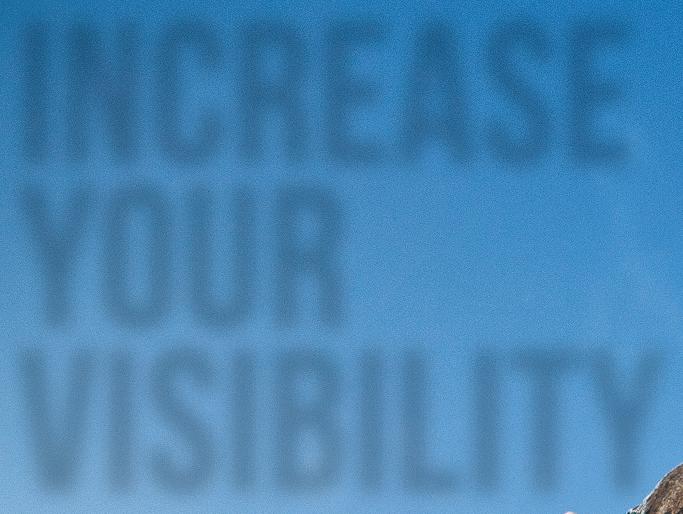


5 WAYS TO BUILD YOUR BRAND AS A TRAINER

SOCIAL MEDIA STRATEGIES YOU NEED IN 2023 TRAINING CLIENTS WITH NEURODIVERGENCE

WWW.PERSONALFITNESSPROFESSIONAL.COM SPRING 2023 Subscribe to PFP
built around your budget CLICKHERETOSUBSCRIBE
Create a plan







us on social to stay connected! @pfpmedia
Follow

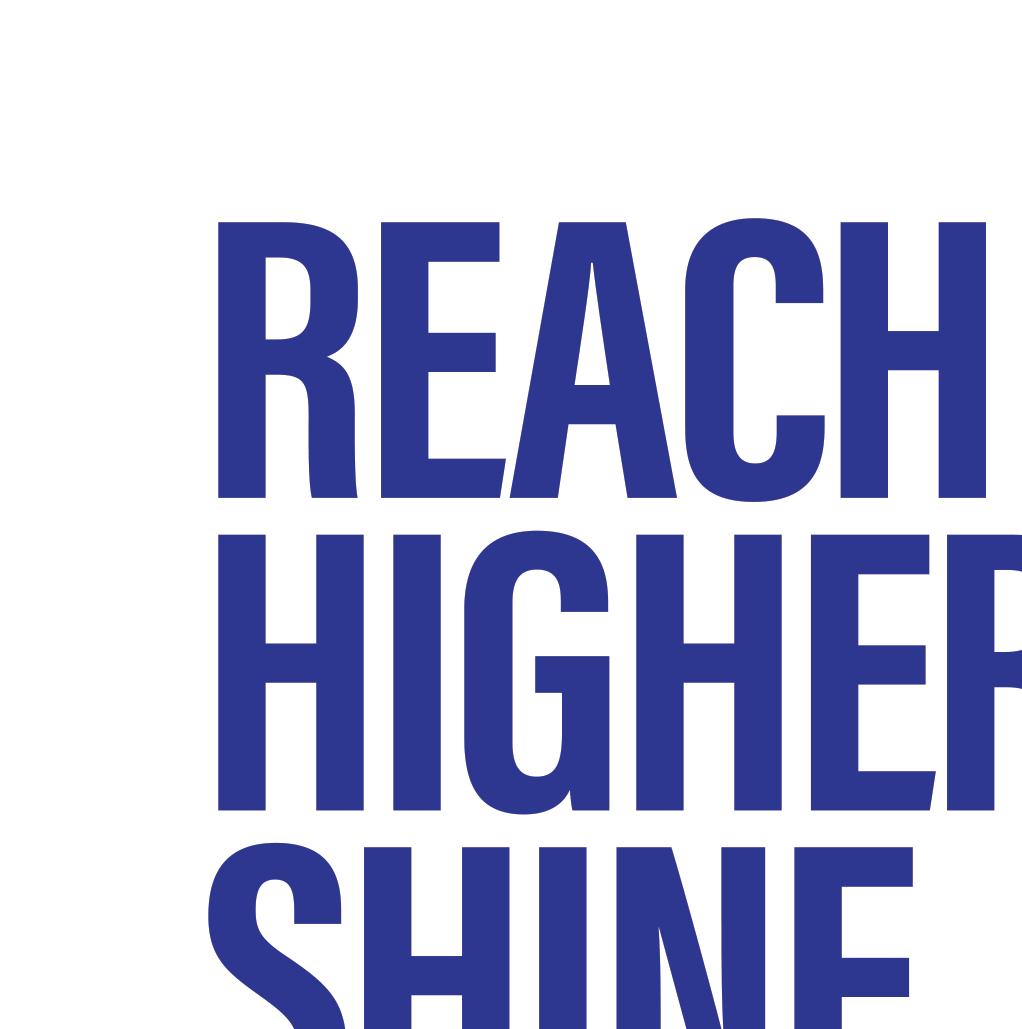




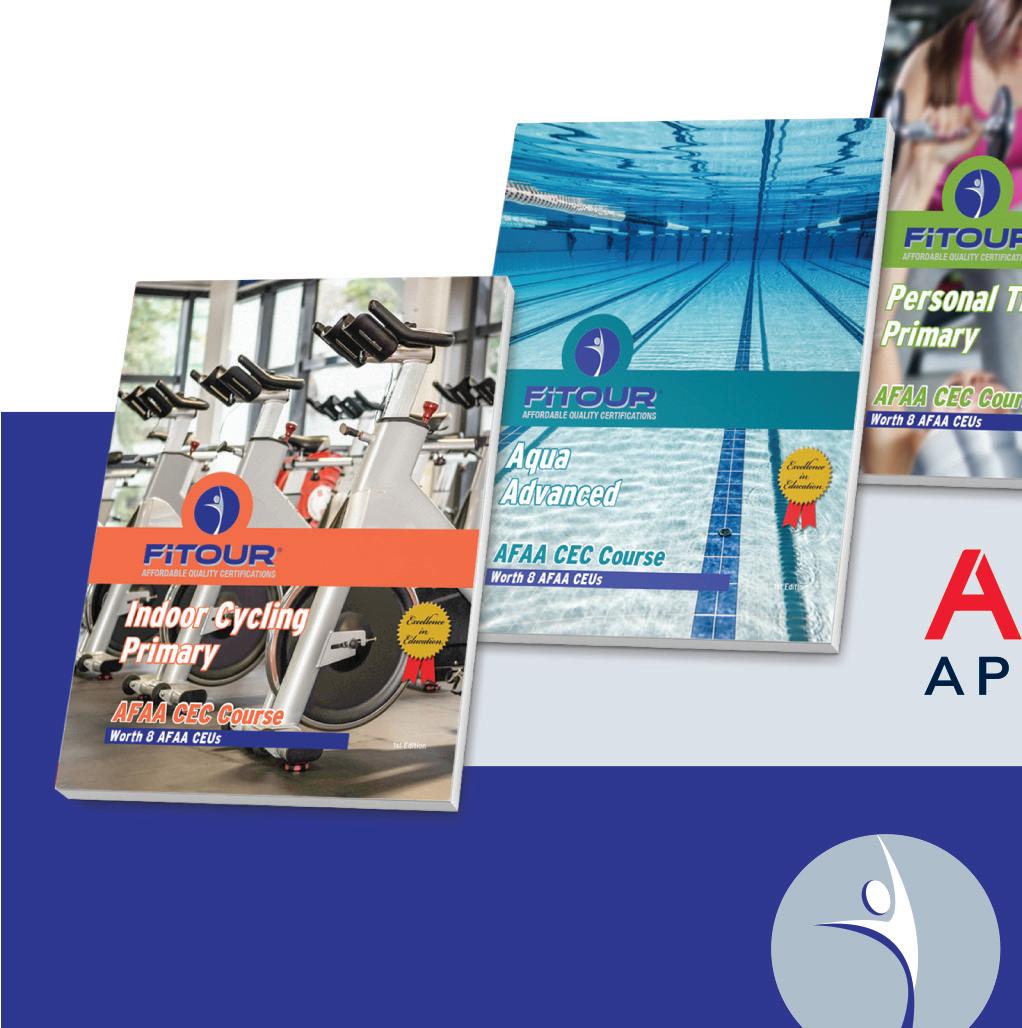


VOLUME 25 | ISSUE 1
president
chad griepentrog | chad.g@rbpub.com
publisher josh vogt | josh@rbpub.com
editor
erin eagan | erin@rbpub.com
audience development manager

rachel spahr | rachel@rbpub.com
national media consultant
josh vogt | josh@rbpub.com
creative director
kelli cooke | kelli.c@rbpub.com
contributing writers
Travis Barnes, Jordon Hvizd, Sheldon McBee, James Patrick, Aesha Tahir, Anna Woods
featured columnists
Brandi Binkley, Trina Gray, Dan Ritchie, Pat Rigsby, Kurt Weinreich Jr.
cover photo
By James Patrick Photography
P.O. Box 259098 | Madison WI 53725-9098.
Tel: 608.241.8777
Email: customerservice@rbpub.com
Print Subscription Information
Subscriptions are free to qualified recipients: $36 per year to all others in the United States. Subscriptions rate for Canada or Mexico is $60 per year, and for elsewhere outside the United States is $80. Back-issue rate is $5.
Send subscriptions to:
By mail: Personal Fitness Professional, P.O. Box 259098 Madison WI 53725-9098
Tel: 608.241.8777
E-mail: rbpub@rbpub.com

Fax: 608.241.8666
Website: www.PersonalFitnessProfessional.com
Digital Print Subscription Information
Digital Subscriptions to Personal Fitness Professional are free to qualified recipients and may be ordered at www. PersonalFitnessProfessional.com/subscribe.
Reprints
For high-quality reprints, please contact us at 608.241.8777
All material in this magazine is copyrighted ©2023 by MadMen3 All rights reserved. Nothing may be reproduced in whole or in part without written permission from the publisher. Any correspondence sent to Personal Fitness Professional, MadMen3 or its staff becomes property of MadMen3.
The articles in this magazine represent the views of the authors and not those of MadMen3 or Personal Fitness Professional. MadMen3 and/or Personal Fitness Professional expressly disclaim any liability for the products or services sold or otherwise endorsed by advertisers or authors included in this magazine.
By Dan Ritchie
Rigsby
Trina Gray
Binkley
Jr.
Butulis
Sheldon McBee
Personal
is
quarterly: Spring, Summer, Fall, and Winter.
25,
Published by MadMen3, LLC C/O Chad Griepentrog 708 Mohawk Trail DeForest WI 53532-3035 Tel: 608.241.8777 Periodicals postage paid at DeForest, WI and additional mailing offices. POSTMASTER: Send address changes to: Personal Fitness Professional | P.O. Box 259098 | Madison WI 53725-9098. One-Minute Practice: Leave the darkness behind By Dr.
Training for Function Power training: Important for maintaining function as we age
Elevate Online Presence Applying offline thinking to online marketing
Pat
Real Talk: Lessons Behind Success Two habits of high performers By
Education
your education
Accelerator
plan, purpose, repurpose
the Experts: Physical Therapy
the gap: post-rehab program design guide
Equity and Inclusion
exceptional and inclusive experiences through coaching and cueing
06 06 30 10 07 10 08 12 28 08 Letter from the Advisory Board Can you answer this question in less than 30 seconds? By Lindsay Vastola New on the Market COLUMNS DEPARTMENTS 16 18
Fitness Professional (ISSN 1523-780X)
published
[Volume
Issue 1]
Adrienne Ione
By
Continuing
Marketing
By Kurt Weinreich
Career
Review,
By Brandi
Ask
Bridge
By Dr. Meredith
Diversity,
Create
By
5 Ways to Build Your Brand as a Trainer





It requires consistency and repetition, so trust the process and know it will pay off
By Anna Woods
Social Media Strategies You Need in 2023

Create opportunities through your content to build trust and establish rapport
By James Patrick
Are You Searchable?

How to boost your SEO and create more traffic flow
By Travis Barnes
OUR ADVISORY BOARD
Training Clients with Neurodivergence
To be successful requires an in-depth knowledge of their unique individual needs, barriers and skills
By Jordon Hvizd
Taming the Hunger Hormones
10 easy, science-backed tips that you can recommend to your clients to stabilize their leptin and ghrelin levels

 By Aesha Tahir
By Aesha Tahir
SPRING 2023 | WWW.PERSONALFITNESSPROFESSIONAL.COM | 5
24
16 18 20 22 24 FEATURES 20
SOCIAL MEDIA pfpmedia pfpmedia pfpmedia pfpmedia pfpmedia Subscribe to PFP today. SUBSCRIBE TO PFP HERE
Lindsay Vastola Greg Justice Farel Hruska Joey Percia
LETTER FROM THE ADVISORY BOARD
By Lindsay Vastola
Can you answer this question in less than 30 seconds?
I was recently talking to a gym owner who said to me:
"Lindsay, when a prospect asks me what makes my gym different, I find myself telling them that they 'just have to come in and experience our amazing community, fun workouts and our highly skilled trainers.’”
He realized his difficulty in communicating what really made him different was seriously impacting his business. Especially, to attract new clients.
The reality is, if a prospect must come into your gym or experience you in person first to understand what makes you different from the other fitness options...
…it’s too late. You’ve lost that client before you even had a chance to win them over.
If you know you provide a second-to-none, life-changing service, but you also know that you're missing too many opportunities to gain new members, here are three questions you need to be able to answer so you can capture more attention, differentiate from your competition, and win more members:
#1: What is the very specific solution you offer that solves a very specific problem?
The truth is... no one is buying fun classes, highly skilled trainers or a great community. Yet this is what fitness professionals keep selling. Even if you have an unlimited marketing budget, consumers will lump you in with “all the same fitness options.” Get clear on the actual problem you solve and the unique solution you offer.
#2: What is the specific journey you provide that will take a client from their problem to their desired outcome?
You know what's all-too-typical with the fitness industry? A trial or short-term frontend-offer with the only next and final step of committing to a long-term membership (even if you offer "month-to-month"... it's really the same to the consumer).
Consumers are fatigued by this model.
What if you offered a unique member journey that told members exactly what they'll experience in the first month, second month, 6 months, one-year and beyond... and why this journey will get them the best results?
#3: How do you effectively articulate your promise, your solution, and your journey?
This is where most fitness professionals and business owners get stuck. But it's the most important piece.
In under 30 seconds (or in one or two headlines on your website or ad copy) — how do you articulate what makes you different? What do you say so your ideal prospect will definitively say, "YES! This is exactly what I'm looking for! I don't have to look any further!" Just as important, that the people who don’t fit your culture say, "Nope... not for me... I'll keep looking."
This is the kind of clarity you must have to truly stand out from the "Sea of Sameness” in the fitness industry and amplify the valuable advice and strategies you’ll find in this issue of PFP.
Let's do fitness... different!
Lindsay Vastola is the creator of Momentum365, a turnkey mindset and habit-change platform for fitness and wellness companies. Lindsay is the founder of VastPotential and Body Project, the former editor of Personal Fitness Professional (PFP) magazine and is a speaker and presenter across industries. Visit LindsayVastola.com.
ONE-MINUTE PRACTICE: PRESENT MOMENT AWARENESS
By Dr. Adrienne Ione Yes2Aging.com

Leave the darkness behind
For some, the month of March signifies a period of transition and transformation — from dark to light. Our modern species gravitates toward a tendency to want to hurry into Spring. Leave the darkness behind. How can we allow March, April and the events that follow in the lengthening of days, to unfold in a way that is calm, reflective and appreciative of what has been gained in the darkness of winter?
Perhaps another perspective of darkness is a recognition that there are light sources that only exist because of darkness — stars, phosphors and chemical reactions, to name a few. From the celestial to the terrestrial we all have the capability for being self-luminous.
Now for others the month of March might be thought of as a verb, which connotes adopting a rhythmic stride. We can create a rhythm by physically marching, or we can turn inward to our natural rhythms (e.g., breath rate, heartbeat, circadian, etc.). According to findings in a recent study, it is suggested that cognitive functioning increases with the adoption of rhythmic step training.
As we explored in the last column and perhaps some have been practicing between now and then to discover the spaces where there is beauty in rest. In what ways can you find a place, in March and the about to unfold Spring days, for the stillness you cultivated in winter?
I invite readers to consider finding spaces where you can allow your own rhythmic stride to unfold. How might you honor and appreciate the stillness you cultivated in Winter? Let’s engage in a 1-minute practice of honoring our internal rhythms and light. Where you are right in this moment is the perfect place to practice. You have everything you need.
1. Locate your light: say, “Hello light. Thank you for shining.”
2. Create a comfortable darkness: Tune into what you can see in the dark.
3. Discover your rhythm: This consists of ons and offs. Name them.
4. Carry your darkness: Maintain an awareness of the beauties you found in darkness and carry these with you into the lightness of Spring.
Repeat steps one through four.
6 | WWW.PERSONALFITNESSPROFESSIONAL.COM | SPRING 2023
By Dr. Dan Ritchie FunctionalAgingInstitute.com
Power Training: Important for Maintaining Function as We Age
Personal training has evolved beyond sets and reps. We’re learning more and more that strength is just one component of our program design. Our clients need a plethora of training modalities to maximize their results.
Musculoskeletal is one of the 6 domains of human function we talk so much about in our Functional Aging Training model. These 6 domains are not just for older clients, but should be considered when training anyone over the age of 40.
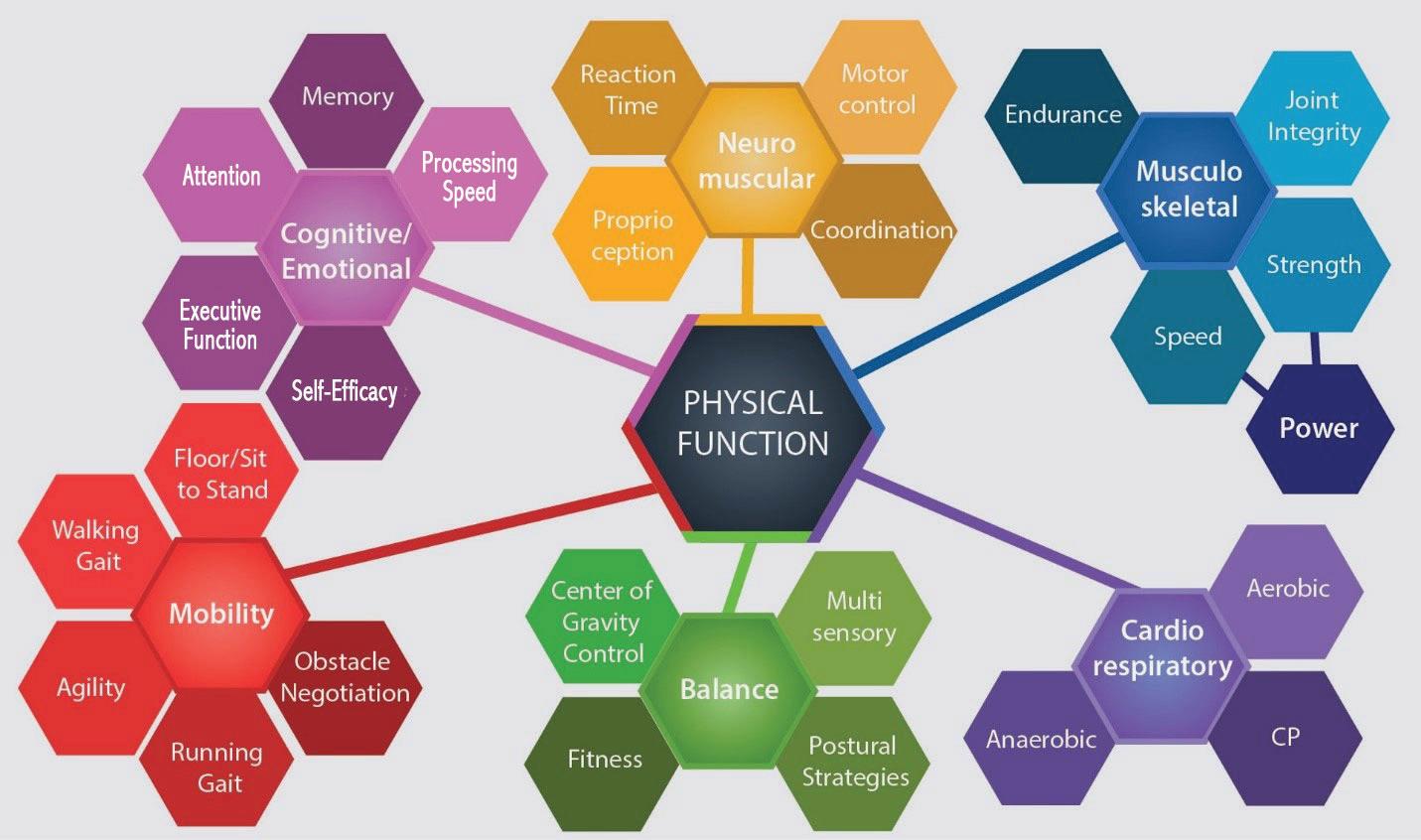
When we look at the musculoskeletal domain, we see that it has 4 subdomains which each have multiple factors. We have shared from over 100 research studies that strength training alone has small effects on overall function. While as trainers we are often comfortable with strength training, we don’t want to forget that we need to be training speed, power and muscular endurance.
We know from the research that power training yields greater functional improvement than strength training alone. So a trainer’s approach has to have a mix of strength, speed, power, range of motion and muscular endurance training stimulus.
Of course, every client is unique. Some need more muscular endurance for tasks like gardening; others need more power for sports like golf. If a client is already having trouble doing chair stands, then lower body strength should be a top priority!
Jumping/Hopping: For speed and power
Jumping, both feet
Hopping, one foot
Jump/hop: Jumping off both feet landing on one foot
Hop/jump: Hopping off one foot and landing on both feet
(For those with significant joint issues faux/jumping, have them attempt to jump as high as they can, but just come up to their tiptoes. You can do that on both feet or on one foot.)
Skipping
Carioca or grapevine stepping (for speed once able)
Side to side shuffling for speed
Of course there are hundreds of strength exercises, but here are some examples:
Chair stands
Power stands
Squatting
Lunge patterns, forward, diagonal, sideways
Split squats
Step-ups
If you are a hands-on learner, we would love to see you out at a live event soon! We have many live workshops and events coming up so be sure to check out our calendar — www.functionalaginginstitute.com
Here are some great examples that take only 5 to 10 minutes and can be incorporated into any training session:
Stepping exercises: For speed and power

Stomping (as if you are smashing a cockroach)
Step to a color as fast as you can (you can use agility dots that have various colors)
Mini sprints, or stepping as fast as you can
Faux falls, leaning forward as if you are about to fall and taking a big step
Check out our upcoming webinar schedule where you can learn more about functional training tips and tactics for training the active aging clientele at FunctionalAgingInstitute.com/webinars.
Dr. Dan Ritchie is the president and co-founder of the Functional Aging Institute. Dan also owns and operates Miracles Fitness in West Lafayette, Indiana, where they have trained over 2,500 clients since 2007. Dan was the 2014 PFP Trainer of the Year and is a sought-after expert and speaker at national and international events on topics like balance for older adults, fitness business development, the global aging phenomenon, and functional aging training models. Learn more at www.functionalaginginstitute.com.

SPRING 2023 | WWW.PERSONALFITNESSPROFESSIONAL.COM | 7
TRAINING FOR FUNCTION
SUBSCRIBE TO PFP HERE
ELEVATE YOUR ONLINE PRESENCE
By Pat Rigsby PatRigsby.com
Applying offline thinking to online marketing
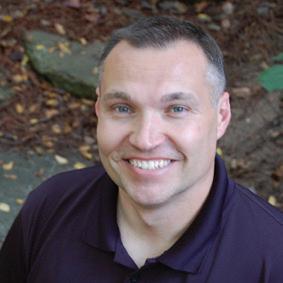
When I think about marketing, it’s really just connecting with people, and there are any number of things we can do online that mirror proven offline methods and will likely boost the results that most businesses are getting. Here are a few.
Membership giveaways are the new lead box. Lead boxes were a source of gym leads for years, and those prospects kept the pipeline full and resulted in a few new clients month after month. You can mimic that same approach by holding a giveaway of a 3-month training program online for people to win. Draw one winner and offer the rest a consolation prize of a free or discounted short-term program.
Google is the new Yellow Pages. Google has replaced the Yellow Pages as the place people go to find solutions and service providers. You can do free listings and paid ads, and you can make your listing stand out from your competitors to attract more prospects who have intent.
Facebook is the new networking. Social networks were intentionally developed to allow people to stay in touch. We can share what we do, form stronger connections, create groups for common interests and so much more. When you think of Facebook as a place to network and create or nurture relationships that ultimately lead to business success, the possibilities are endless.
Online ads are the new commercials. People engage in social networks or video platforms to be entertained and ads are an interruption. Not many people log on to Instagram to shop. So develop ads with that understanding. Create low friction next steps rather than asking for an immediate sale and follow up with people to build value and demonstrate how you can serve them.
People are still people. The people you’re trying to engage with online are simply people, not profiles, impressions or anything else. Treat them the way you’d want to be treated. Base your expectations of them around what you might expect if you tried to engage offline. Be helpful. Demonstrate how you can serve them and assist in solving their problems or achieving their goals.
Online marketing is a wonderful vehicle to grow your business, but we can’t lose sight of the fact that we’re trying to connect with people who actually live and function offline. If you watch how most online marketing is done, not much of it actually prioritizes the prospect and how they think and feel. Do that and watch your business grow.
REAL TALK: LESSONS BEHIND SUCCESS
By Trina Gray TeamRockstarFit.com
Two habits of high performers
I am a success junkie. I love making vision boards, setting goals, hitting achievements, earning income and growing as a leader. I am also a life junkie. I love unplugging, relaxing, traveling and simply enjoying the moment. Two habits that have helped me commit to both are creating a morning routing and keeping a daily journal.
1. Create a morning routine — There is never a perfect time in life to get your mornings in order. Your morning routine will change as your life changes, but do not try to wing life without one. There will always be some level of chaos and things out of your control. However, when we create morning routines, we tend to prioritize habits that matter to us, and make life work around them. My current routine is self-care before any scrolling, computer work or zooms. I start with a guided stretch followed by a 30-minute strength workout at home. I follow up with a superfood shake and a chapter from a personal development book. This is like clockwork. I refill my water bottle, review my schedule, adjust my to-do list and get on with my day. In total, it’s an hour and I rarely miss it.
My two recent books are Lighter, by Young Pueblo and Slowing Down to the Speed of Life, by Richard Carlson and Joseph Bailey.
2. Keep a daily planner — Track the lessons you learn in your reading, capture your thoughts and ideas on paper. Be organized about your calendar and your daily to-do list. A scattered system is the sign of a scattered life. Find a system that you’ll stick with. I keep a spiral bound daily journal for my ideas and my to-do list. I track all of my appointments, meetings and calls in my Apple iCal. I color code the activities according to my “roles in life.” It’s a very easy way to visually look at my week and see what I’m missing, or if I’ve lost all sense of balance.
Example: blue is self care (workouts, massage, chiropractic care, hair/nails, therapy), purple is family (kids sports, school events, kids’ doctor’s appointments, college tours), red is my health club (leading fitness classes, team meetings, admin work) and orange is my BODi coaching team (mastermind zooms with fit pros, running online fitness challenges). It’s a very easy way to visually look at my week and see what I’m missing, or if I’ve lost all sense of balance. Success is not always about doing big things. It’s about doing the small things better.
Pat Rigsby is one of the fitness industry's leading business coaches and the owner of PatRigsby.com. He has built over a dozen businesses in the fitness industry as a CEO and co-owner, ranging from two-award winning franchises to certification organizations and equipment companies. Now he focuses exclusively on helping fitness entrepreneurs build their ideal businesses.
Trina Gray is a leading entrepreneur in the fitness industry with 20 years of experience. She owns Bay Athletic Club, a medically based health club in Michigan. She founded a top on-line coaching team with BODi (formerly Beachbody), called Team Rockstar Fit. She mentors fit pros to expand their income, reach more people outside of sessions and classes. Connect with her at trina@bayathleticclub.com or IG @trinagray

8 | WWW.PERSONALFITNESSPROFESSIONAL.COM | SPRING 2023




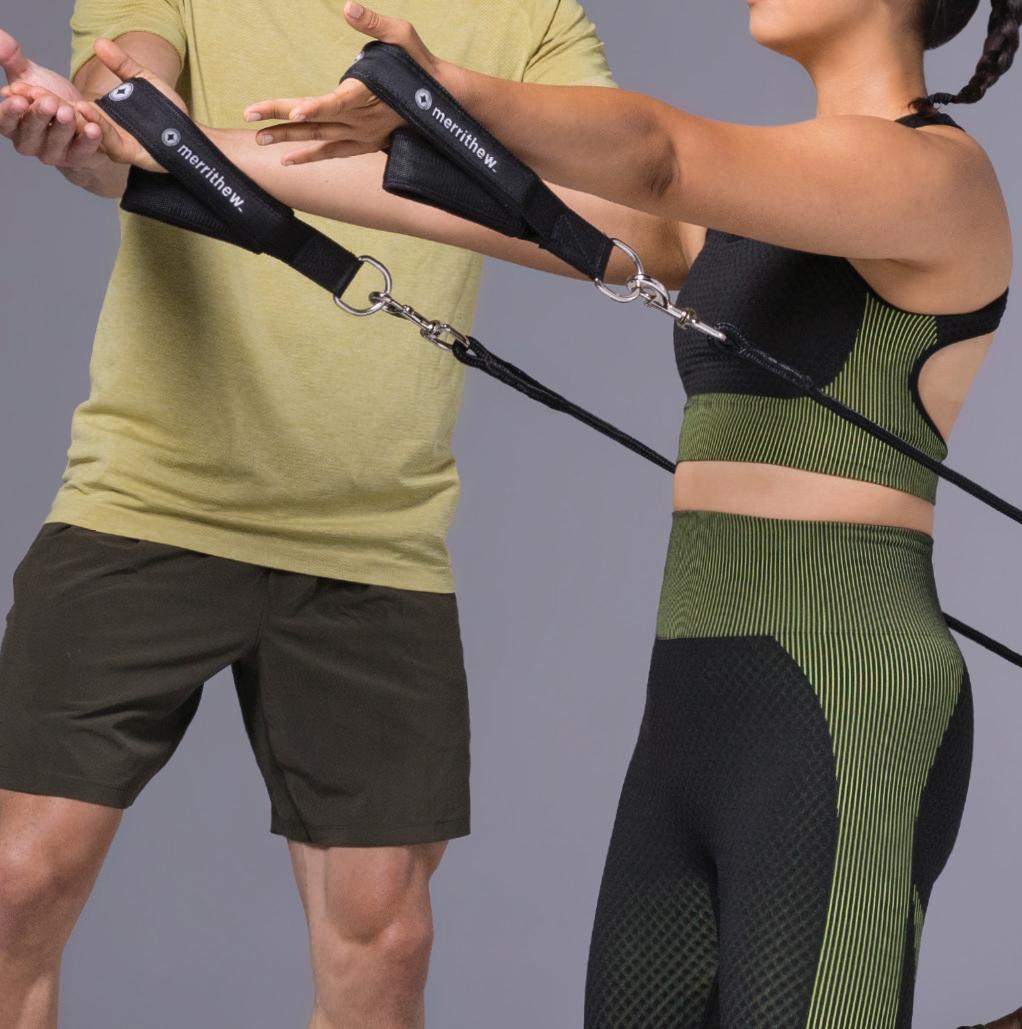


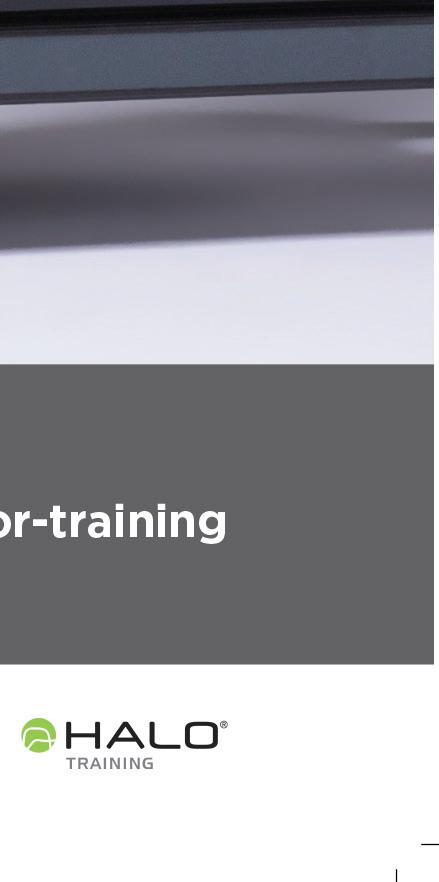 By Kurt Weinreich Jr. KurtWeinreich.ISSACertifiedTrainer.com
By Kurt Weinreich Jr. KurtWeinreich.ISSACertifiedTrainer.com
Marketing your education
Continuing education is the standard to maintain certi fication status but can also be utilized as a marketable tool to enhance credibility, showcase skills and provide auxiliary services to clients. Keeping abreast with the newest research on nutrition, programming, equipment, and special populations allows plenty of content for expanding your portfolio.
These factors can certainly dictate which courses to take in regards to enhancing your current credentials, but research in current trends will keep the fitness professional in a position as an industry leader. National conferences offer a variety of courses that can be applied to multiple client goals. Focused singular courses can be concentrated on a particular modality of interest for a specific demographics. Once obtained, it would be beneficial to market these new skillsets to increase the value in your programs.
To Current Clients. After your course, share your newfound education with your current clients. Incorporate it into their programs and showcase how this information benefits them. This will demonstrate the value of their investment in you will keep growing, which will allow for increased resigning percentage. They will undoubtedly share what they learned to close associates, which can lead to referrals.
Marketing in the Facility. Once you are comfortable with the content, begin showcasing these new skills in the facility. For certifications, update in-club biography while offering consultations in that area. Smaller courses can be marketed in the gym with seminars, classes and demonstration tables. These methods should be expanded into cross-marketing with outside facilities.
Marketing Online. We are in a time where online presence is just as important, and showcasing new education is a great way to rapidly express your interests while providing new content. Posting pictures participating in the educational event validates credibility while networking. Small videos demonstrating new skills will show how you will incorporate them into your programs. Tagging media of the equipment used or courses taken may expand into sponsorship and discounts on further education. All of these should be shared on social media platforms, club websites and professional listings for optimization.
While continuing education will certainly enhance your professional worth, purposeful considerations of utilizing the marketability of the courses can expand the value of your investment and provide measurable returns in the field.
CAREER ACCELERATOR
By Brandi Binkley GetPhysioFit.com
Review, plan, purpose,
Executing an attractive marketing and visibility plan can be tricky and sometimes costly; however, it is necessary for your business to thrive in the marketplace. Keep in mind that these two things are a collaborative effort, nevertheless different. Marketing is the act of reaching your target market with specific services or products. Advertising and selling would be examples of marketing. It’s how you get a product or service out to the marketplace and sell it. Visibility is how your brand is seen and perceived, it’s your story, how you show up in the marketplace and over time what you become known for.
Have you struggled with marketing in your business? If so, it’s likely due to one or all of the following: no annual plan, no budget or the wrong target market. A marketing and visibility plan built around your budget, your abilities and your calendar is a great place to start.
Budget — Take a look back to see what you spent last year, how much of that capital did you get a return on? Most agencies will recommend spending 5%-25% of your annual budget.
Abilities/scope — Be sure to set your marketing efforts to drive programs in your business that are within your skillset AND what your clients need. Do not get distracted by the shiny object unless you have done beta testing to assure its going to be a profitable option for you.
Calendar — Plan your annual and quarterly calendar well in advance of marketing and scheduling programs or new services. If you are marketing existing services that are already profitable for you then be sure to delineate those on your calendar throughout the year as not to have any gaps. This is a good place to utilize multiple forms of marketing.
As with most things in business you get what you pay for. Be sure to have at least 2 outlets for marketing and visibility consistent in the public eye. Repurpose content — just because you are tired of it doesn’t mean your customers are nor does it mean that potential customers have seen it. The options for marketing are endless, however the important thing to remember is that variety wins until you are able to dial it down to the key avenues that get you a return on the investment you allocate to your marketing and visibility plan.
Kurt Weinreich has over 22 years of experience in the fitness industry as a personal trainer, professional educator and fitness manager. Kurt continues to train full-time in Colorado while developing fitness professionals through consulting, lectures and internship programs.

Brandi Binkley has been an Exercise Physiologist for 19 years. Her first company PhysioFit has been called the Gold Standard for its interdisciplinary approach to technology and the clinical space. She has served as a consultant to the Department of Defense, Alpha Warrior, Technogym, and multiple healthcare companies. Brandi also spends her time serving on the board for End Slavery TN, Tennessee State NSCA Advisory, C12, and The Todd Durkin Mastermind.
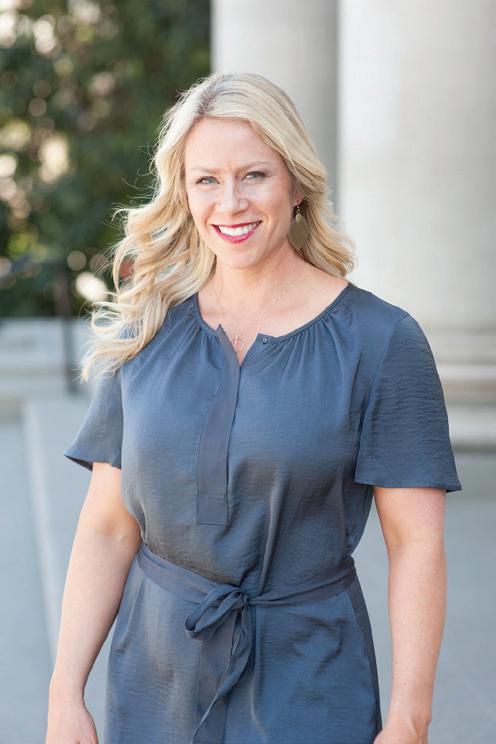
10 | WWW.PERSONALFITNESSPROFESSIONAL.COM | SPRING 2023
CONTINUING EDUCATION
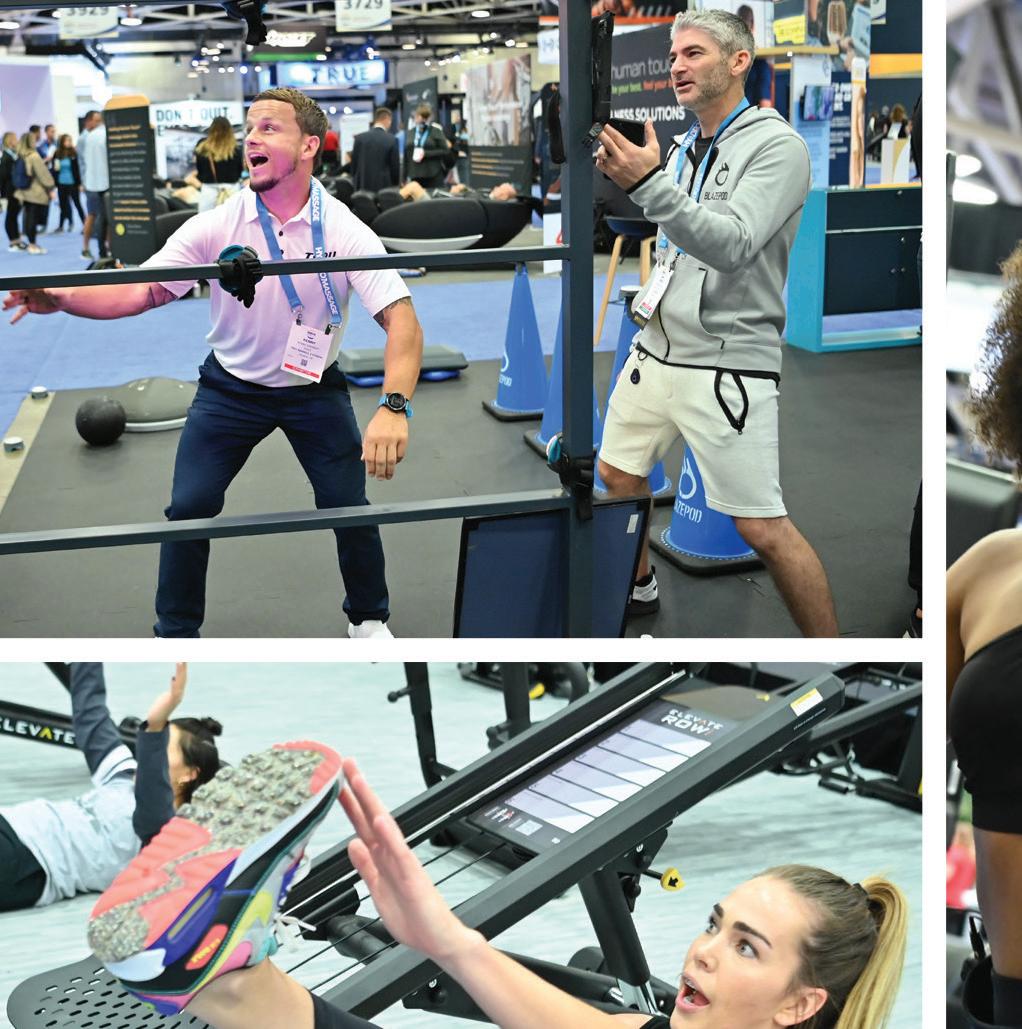






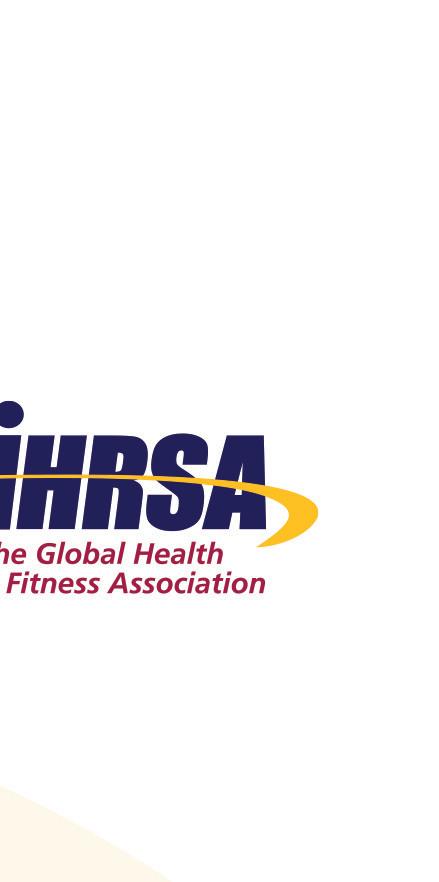 By Dr. Meredith Butulis MeredithButulis.com
By Dr. Meredith Butulis MeredithButulis.com
BRIDGING THE GAP: POST-REHAB PROGRAM DESIGN GUIDE
Part 2 — The movement safety zone | By
Dr. Meredith Butulis
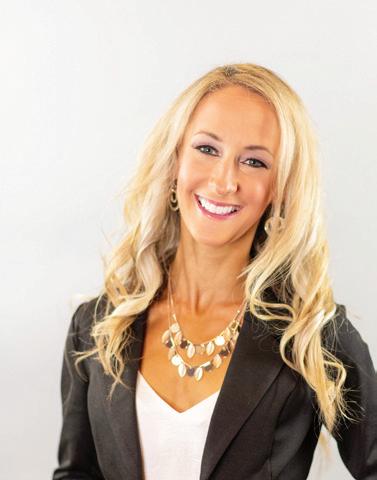
Welcome back! Last issue in part 1, we set the foundation to re-build post-rehab client tissue tolerance. Re-establishing tissue tolerance alone, however, is not enough to train movement performance. Movement performance progresses into program design part 2: expanding the movement safety zone.
Ever hear of someone stepping off a curb and breaking his/her ankle? Incidents like this are common. The body’s neuromuscular control was not responsive enough to adapt to the unusual angle, speed or load. This lagging response is often due to a lack of movement experiences — the nervous system simply doesn’t have enough training to know how to respond!
When returning to fitness post-injury, clients have been in a controlled rehab environment for some time. Fitness professionals
serve a major role in restoring the breadth and depth of client’s automatic movement vocabulary through functional training. Functional training can be defined as compound exercises involving multiple muscles and joints moving in concert.
Some trainers divide functional training into categories such as push, pull, hip hinge, squat and lunge. Others divide functional training into sling systems such as posterior oblique, anterior oblique, deep longitudinal and lateral. Functional training to restore neuromuscular control, however, is not as simple as implementing neatly categorized exercises from a textbook.
Common functional training implementation mistakes include:
1. Excluding movement fluency
2. Introducing functional training too early
3. Stopping short on speed and load progressions
Part 1: Build movement fluency
Functional training frameworks are only the starting point to include a variety of essential motions. Consider this: how many times has your client heard “don’t let the knee pass the toe?” What happens when that same client performs a running acceleration drill? Proper acceleration not only allows, but also requires the knee to cross forward of the toe. If the client’s first post-rehab exposure to the position is at full speed, however, injury is likely.
Instead, the client needs help with gradual exposure to multiple movement possibilities that are often not included in controlled rehab environments.
General themes from which to build movement fluency include:
Begin with one plane, progress to multiple planes
Begin with a stable surface, progress to an unstable surface


12 | WWW.PERSONALFITNESSPROFESSIONAL.COM | SPRING 2023
ASK THE EXPERTS: PHYSICAL THERAPY
SUBSCRIBE TO PFP HERE
Begin with a smaller motion, progress to a larger motion
Begin with less distraction, progress to more distraction and even reaction





Begin with simple single movements, progress to higher complexity sequences
Begin with slower motions, progress to faster motions
Include both open and closed chain variations
Post-Rehab Program Guide

When considering so many variables, start with one theme. Next week, pick a different theme. The client must be allowed enough time to explore the theme to demonstrate at least initial competency, but not so much time that other themes are ignored. Once an individual theme has some level of competency, themes can be combined. When the client has multiple goals, movement fluency can be developed during the warm-up.




Here’s a movement fluency warm-up example for a field sport athlete returning to personal training 9 months after an ACL tear:
Week 1 foundations: Learn a basic dynamic warm-up that incorporates all planes of motion. Begin with slow speeds and small motions. Progress to moderate speeds with medium size motions. Perform this warm-up in low-distraction area with an even floor.
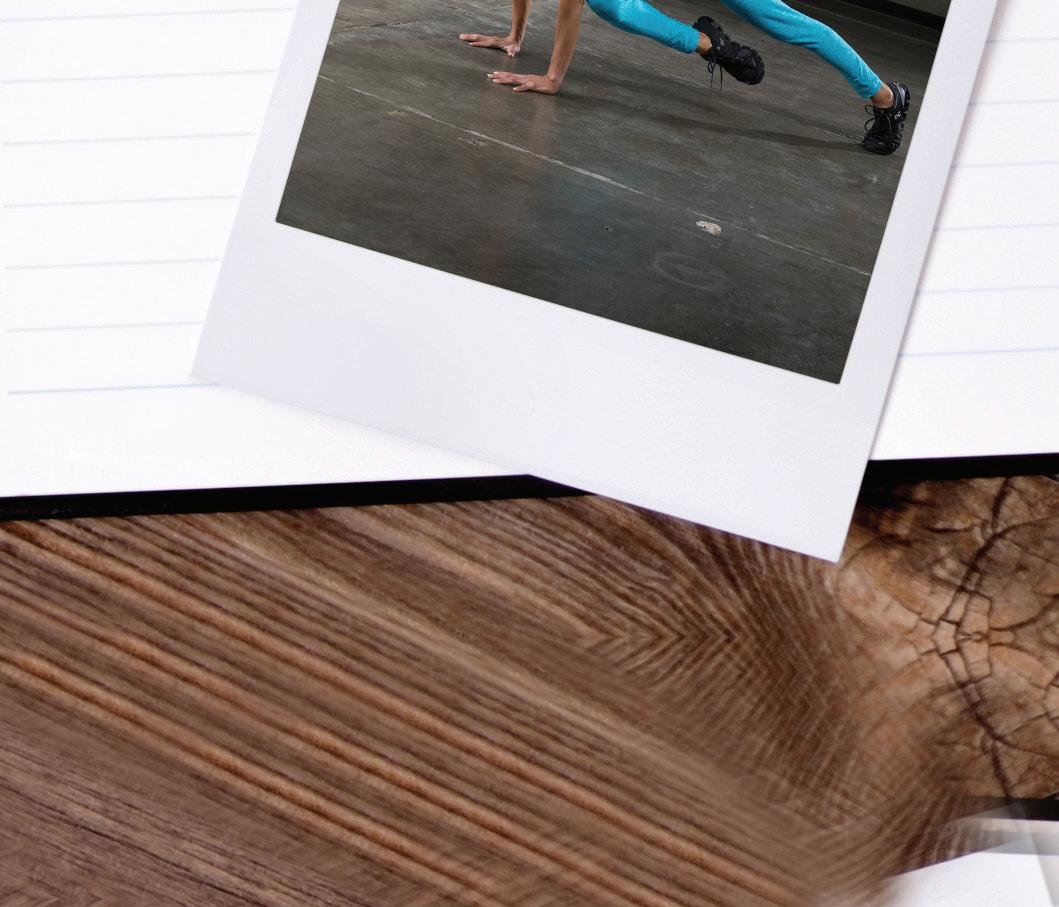


SPRING 2023 | WWW.PERSONALFITNESSPROFESSIONAL.COM | 13
FITNESS PROFESSIONALS SERVE A MAJOR ROLE IN RESTORING THE BREADTH AND DEPTH OF A CLIENT’S AUTOMATIC MOVEMENT VOCABULARY THROUGH FUNCTIONAL TRAINING.
Photo Credit: James Patrick Photography
Week 2 movement expansion: Perform the same warm-up, progressing to larger expressions of each movement by the end of the warm-up.

Week 3 speed development: Perform the week 2 warm-up, progressing to 80% of “full speed” by the end of the warm up.
Week 4 movement expansion: Perform the week 3 warm-up, adding large complex novel movements like level changes into burpees.
Week 5 uneven surfaces: Perform the week 4 warm-up outdoors on the grass.

Week 6 simple reaction: Perform the week 5 warm-up with a reaction element, such as performing the burpee on your whistle.

Week 7 sequenced reaction: Perform the week 6 warm-up with an additional sequence on your whistle. For example, when you blow the whistle, the athlete needs to do a burpee, dribble a soccer ball for a certain distance, then pick up the ball and throw it back.
Week 8 complex reaction: Perform the week 6 warm-up, but a single whistle indicates progression into one sequence and a double whistle indicates progression into a different sequence.

Part 2: Bridge the functional movement gap with activation
When physical therapists and fitness professionals use the word “strength,” they often mean different things. Lack of awareness surrounding this difference opens the gap for functional training-induced re-injury.
As an example, a physical therapist shares that a client needs to work on glute strength. The fitness professional has the clients do squats. Logically, squats work on glute strength and they help the client restore function. In line with tissue tolerance development guidelines, the trainer progresses the load. Suddenly the post-rehab client is sidelined by hip pain, back pain or a strange ripping sensation through the sacroiliac (SI) joints. What happened?
Physical therapists typically measure strength with manual muscle tests. A man-

14 | WWW.PERSONALFITNESSPROFESSIONAL.COM | SPRING 2023
ual muscle test refers to isolated concentric strength against a very specific manually applied resistance. Squats are a compound exercise. Compound exercises utilize muscles in concert, as opposed to isolation. If the glutes are underactive and a client continues to increase load on a compound exercise like squats, stress shielding occurs. The underactive muscle, in this case the glutes, will allow stronger muscles like quads, hamstrings and numerous back muscles to take up their share of the load. The higher the load goes, the more the weak muscles shield themselves from participation, and the more the strong areas pick up the load in compensation. Muscles can only take up so much compensatory slack, so when the load crosses the client’s progression threshold, ligaments, cartilage or discs help too. As the non-contractile tissues substitute, they signal the problem with pain or motion loss.
What can fitness professionals do to help clients avoid functional training stress shielding?
1. Follow tissue tolerance recommendations by progressing strength in isolation, and also training unloaded movement patterns in the first two returnto-training months.
2. Fitness professionals can ask the physical therapist if the client has specific weak muscles on manual muscle tests. For these muscles, include an activation set prior to functional training movements. For example, if the glutes were not fully strong on manual muscle testing, the fitness professional can ask if “glutes” refers to the gluteus maximus or medius. A sample activation exercise for the gluteus maximus is the hip bridge. A sample activation exercise for the gluteus medius is a side knee plank with repeated hip abductions. Activation is not about sets x reps; in fact, 1 x 10 without an external weight is often sufficient. The secret to success with activation exercises lies in exquisite body alignment, client cueing to pre-squeeze the desired muscle
prior to moving, completion of a single rep, returning to rest, then starting over. This intentional re-start from the beginning for every rep teaches the nervous system to prime the muscle to participate in the activities that follow.
(or one that emphasizes the same muscle groups) for as many reps as possible in 30 seconds. For this round, use no more than 30% of the heavy load.
As an example for an adult recreational volleyball player returning to fitness 8 months after a rotator cuff repair:
Exercise 1: Elbows in push-ups x 6-8 reps.
Exercise 2: 6 lb med ball chest pass to a trampoline as many reps as possible in 30 seconds
Perform 3 rounds with a 3-minute rest between supersets.
Tying it together
Part 3: Progress speed and load instead of stopping short
The controlled movements common in the rehabilitation environment help patients re-establish safe movement efficacy without over-stressing injured tissues. When the client is ready to develop the speed and load for fitness and athleticism, they re-enter the fitness environment. Now it is the fitness professional’s responsibility to continue bridging the gap to high level performance.
Re-establishing speed and load capacity can be accomplished through supersets. After completing the general warm-up and resistance exercise warm-up set, here is a simple formula that can be applied to almost any resistance-based exercise:
Exercise 1: Perform the exercise with a heavy load for 6-8 reps.
Exercise 2: Perform the same exercise
After re-establishing tissue tolerance, post-rehab clients need fitness professionals’ help to build their movement zones of safety. After checking with a client’s rehab team on any specific needs and boundaries, the fitness professional’s inclusion of movement fluency, activation preceding functional re-integration and speed and load progression can help bridge the gap for return to high level fitness and athleticism. The rate at which the client’s capabilities are restored, depends not only on program design, but also the fitness professional’s art of cueing. Stay tuned for part 3 of the Bridging the Gap series, Building your Cuebox, in the next issue of Personal Fitness Professional.
Dr. Meredith Butulis, DPT, OCS, CEP, CSCS, CPT, PES, CES, BCS, Pilates-certified, Yoga-certified, has been working in the fitness and rehabilitation fields since 1998. She is the creator of the Fitness Comeback Coaching Certification, author of the Mobility | Stability Equation series, Host of the “Fitness Comeback Coaching Podcast,” and Assistant Professor the State College of Florida. She shares her background to help us reflect on our professional fitness practices from new perspectives that can help us all grow together in the industry. Instagram: @Dr.MeredithButulis.
SPRING 2023 | WWW.PERSONALFITNESSPROFESSIONAL.COM | 15
Clients need help with gradual exposure to multiple movement possibilities that are often not included in controlled rehab environments.
By Anna Woods SheStrength.com
5 WAYS TO BUILD YOUR BRAND AS A TRAINER

Personal trainers learn about helping clients and exercise selection in their certifications and education, but one area that is typically overlooked by many new trainers is building a business and a brand. Building a brand revolves around marketing and understanding how to educate and influence people.
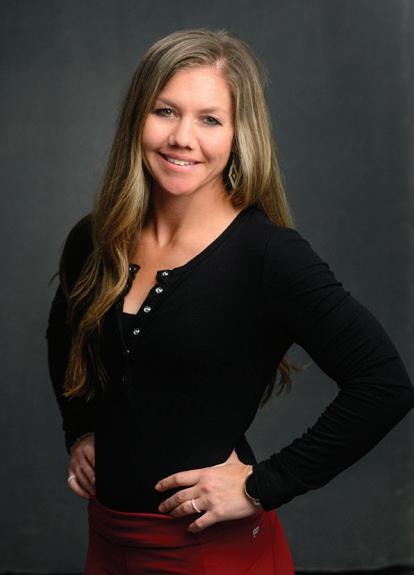
1. Understand your authentic self as a personal trainer and know the type of people you want to attract.
Sharing your true self is a key indicator in good marketing. But sharing yourself can only occur if you know yourself, your best qualities
and how to best share them. This begins with several questions:
Are you more funny or more serious and inspirational?
What age are you and what age group of clients do you want to attract?
Are you a better writer or a better speaker?
Answering these 3 questions will help you determine where to begin: If you are funny, share funny thoughts, memes and videos of yourself or your clients/situations, etc. If you are more inspirational, share quotes, testimonials of clients or yourself overcoming obstacles. Do
not try to mimic what you see other trainers doing if it doesn’t fit your personality type. Just because a trainer has a lot of followers and is funny, doesn’t mean you should try to be funny, if humor isn’t your forte.
Depending what age you are and what age of clients you plan to attract will determine which platform to use for social media and sharing. It will also help you determine the best time of day to post, so more of your “true audience” will see it. Older clients tend to login early morning and later in the evenings. Younger crowds tend to be more present early evening and weekends. Sunday
16 | WWW.PERSONALFITNESSPROFESSIONAL.COM | SPRING 2023
FEATURE ARTICLE
It requires consistency and repetition, so trust the process and know it will pay off |
By Anna Woods
nights are great times to post for all ages/ audiences. Lastly, if you are a better writer you will want to pursue Twitter or Facebook that are more inviting to writing. If you prefer videos and speaking, TikTok and Instagram reels may be more your strength.
2. Include yourself in as many marketing pictures as possible. People need to know the face behind the name early in a personal trainer’s business. It is important to have pictures of yourself training, interacting, speaking to and engaging with your clients or class. People find comfort in seeing your face and it eases the insecurities they may have when they can see you personally, helping someone like themselves. It also helps people associate your face with your brand and who you train.
Set up a tripod and set a timer on it while you are training to snap pictures of you in action. Another option is to leave your camera recording video while training a client and use the video or take screenshots out of the video to use for promotional purposes. Also, ask group members to take pictures of you while working with their small groups. When speaking at events, ask the event organizer to take pictures with your phone to use for promotions. Try to record yourself in as many different ways as you can and reuse these images for all types of postings—duplication is key to people remembering who you are. Another great option with video or pictures is to include your brand or logo in the image. The app stores have many great options for apps to help you quickly add your logo to any images you use — this prevents people from using your images for their own personal use and also helps people continue to tie your face with your business and brand.
3. Set up a Google account and create an identity in Google searches, Google maps. Set up Google business account at www.business.google.com and begin posting updates, articles, blog posts, social media pictures and pictures to bring brand awareness and gain credibility in search engines and in Google maps. Verify your physical address through
Google maps so people can search your location and post pictures of your storefront or gym front. Setting up a Google account will also help your business name and location show up as suggestions on maps when people are driving in your area of work.
Encourage current members, clients, friends, family to leave Google reviews to also help search engine optimization (SEO). Finally, finish the account setup by including hours or operation, service options with specific pricing and offerings, and link it to your website address if you have one.
customers in your business. Reducing the value of yourself and your services at the beginning of your training career automatically reduces your worth in the eyes of the people seeking your services. When a person does not have any skin in the game, through payment for your services, they are not obligated to show up or continue training with you. Free or reduced payments also attracts clients who are not truly ready to commit to bettering their health and fitness, most of the time. People commit to free or cheaper rates because it is convenient, not because they are committed. To truly help people get results and improve their health, they need to be ready and committed and that includes paying you for your time and expertise.
4. Volunteer.
As you begin to determine the clientele you want attract, start to research boards, events and activities that you can volunteer to be involved with. Volunteering provides opportunities for you to network, meet people and gain empathy and understanding towards the systems that support the clientele you want to help. Some ideas include: 5Ks, charity events, school fundraisers, community causes, coalition for non-profits, sports and recreation committees, school or community after school clubs/programs, etc. At these events, bring water bottle stickers, t-shirts or kitchen magnets to hand out with your information on them. Offer gift items with your business information, gift cards and apparel for silent auctions or giveaways. These are the type of events to donate your time and energy for free.
5. Do not offer free or reduced items in your marketing for services. Free does not equate to more clients and
Remaining true to who you are and the clients you want to attract, establishing a solid business storefront through Google searches and not undermining your business worth through reducing prices are keys to growth. Also understanding building trust and an authoritative voice in this industry takes time and patience — it will not happen overnight or even in a year. Building a brand requires consistency and repetition, so trust the process, and know the systems you have in place will eventually pay off, even if it feels slow at first.
Anna Woods, ACE-CPT, BMES was a 2022 IDEA World Personal Trainer of the Year nominee. Anna earned her degree in Exercise Science in 2005. Her credentials include ACE-CPT, Biomechanical Exercise Specialist, CF-L1, DNS Running/Weight Training/Exercise 1, Functional Aging Specialist, PFP Personal Trainer of the Year Finalist (2017). She has been in the fitness industry for over 17 years and currently is the CEO of sheSTRENGTH, an online and in-person fitness/training program. She trains women and youth of all abilities in her barn gym in Buhler, Kansas. She is the strength and conditioning coach for the Hutchinson Community College NJCAA softball team and Buhler High School lady athletes. She is also the author of the book and CEU course, “Adaptive Fitness Exercise Programming,” which trains coaches, teachers, and trainers how to work with athletes with special needs. Follow her on IG or Twitter @shestrength.
SPRING 2023 | WWW.PERSONALFITNESSPROFESSIONAL.COM | 17
SUBSCRIBE TO PFP HERE
People need to know the face behind the name early in a personal trainer’s business.
By James Patrick JamesPatrickPhotography.com
SOCIAL MEDIA STRATEGIES YOU NEED IN 2023

Create opportunities through your content to build trust and establish rapport
By James Patrick
In 21 years, I’ve managed to create three things that went viral online. That is one viral piece of content every 7 years. Truthfully, that is a far better average than most who may never create any content that catches fire and spreads.
In order to validate the importance of creating content that becomes infectious, one must factor in the amount of revenue that was procured, directly or indirectly, as a result. In my case, those three pieces of content which totaled into the hundreds of thousands of im-

pressions, likes, views and shares, cumulatively has netted me a whopping total of zero extra dollars. More money is to be found digging through the center console in my car.
Believe me, I wish the reality was different and I was receiving a check from, I don’t
18 | WWW.PERSONALFITNESSPROFESSIONAL.COM | SPRING 2023
FEATURE ARTICLE
|
know, The Internet Corporation of the World, compensating me for my efforts. Yet as much as I tried to twist the data, zero dollars is the result for creating content that was consumed by a vast number of people.
Perhaps this revelation is not even remotely surprising for you. If that is the case, why are each of us so obsessively consumed with the number of likes, comments and views we are receiving? Why are we so concerned with vanity metrics that don’t actually move the needle forward in our business? Because what we want and what our business needs are two separate things.
We want adoration and validation for the work we do. Our business needs real prospective leads to sustain and to grow.
This article will not teach you how to go viral. Even if I did know the trick, all that
would yield is having your content consumed by those who are not a part of your target audience or prospective client pool.
You need to know how to create the right content so that the right audience can consume it at the right time which implores them to enter into your ecosystem as a lead or even as a client. There has also never been a more difficult time to accomplish this task.
It used to be significantly easier to communicate a message of an offer with value to an audience and onboard a percentage as paying customers. Yet as each year passed, we as consumers on social media, became moreand-more bombarded and overwhelmed with advertisements, promotions, sponsored posts and marketing content all vying for our attention and a piece of our wallet.
The result is, we as end users started to tune everything out. If we even get the whiff of an advertisement, we immediately scroll past. That is not why we opened up Instagram or Facebook.
Our reasons for even getting on social media is to see content that entertains us, content that educates us or content that inspires us. We are not getting on social media holding a credit card just waiting for the right advertisement to prompt our shopping spree.
That may seem frustrating for you, and me, as entrepreneurs trying to promote and sell our products and services — but in reality, it is an indicator that our approach on these platforms needs to mature.
First, the content we create has to achieve the needs of what our audience is looking for. Our role as a publisher is to entertain, educate or inspire our target audience. The content we create and distribute should connect to the problem we ultimately solve or the clear and specific benefit we offer. This helps position you and your business in the mind of the consumer.
Second, we have to consider where we are distributing our content. Instagram, which for many was once an effective selling tool, has now helped shape an audience with a shorter attention span than ever before. This means that any long-form or heavily promotional content will not perform well on this platform.
Thus, our usage of Instagram has evolved into the platform you use to create a quick digital introduction (a handshake) and an invitation to the audience to take a next step to enter into your ecosystem.
This step could be a request for them to message you directly to carry on a conversation or an opportunity to get off the platform and onto another platform where you can deliver different, even long-form content. This could be subscribing to your podcast, joining your email or SMS list, becoming a member of a private Facebook Group, opting into your YouTube Channel, etc.
The request for the next step, or call to action, is important because anyone who takes this action is clearly signaling back to you that they are engaged in your brand and are much closer to being a paying customer.
It will be here that you will have the opportunity to forge a better relationship with the prospect through longer-form content without the limiting attention span constrains that Instagram possesses.


It is also here that you can deliver your sales offers to a now segmented audience which has already indicated to you that they are paying attention and are willing to consume more of your content. These are significantly warmer leads.
If there is one word to hone in on for your social media strategy this year, that word is nurture. Your audience wants and deserves to be nurtured longer than they have previously. Your role is to create opportunities through your content to build trust and establish rapport.
Consumers need to be seen and heard. It is our responsibility to provide that.
James Patrick is an internationally published photographer with more than 600 magazine covers to his credit, a best-selling author, podcast host and marketing strategist. He works with professionals to help them increase their awareness leveraging the power of earned media to ultimately grow their revenue. His work can be see at https://jamespatrick.com/coaching or on Instagram https://www.instagram.com/jpatrickphoto
SPRING 2023 | WWW.PERSONALFITNESSPROFESSIONAL.COM | 19
SUBSCRIBE TO PFP HERE
By Travis Barnes JourneyFitness333.com
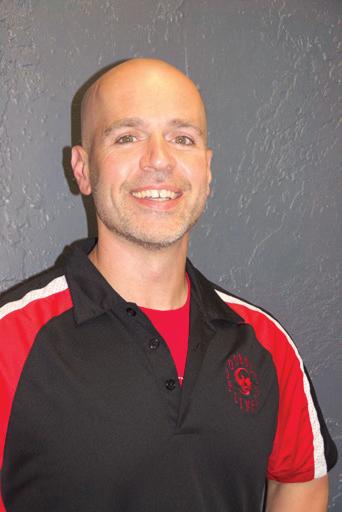
ARE YOU SEARCHABLE?
How to boost your SEO and create more traffic flow
By Travis Barnes
Did you know 68% of online experiences start with a search engine? Ask yourself, are you searchable? Perhaps just as important as hanging your sign on your building or getting a business card is setting up your Google Business Profile. This allows you to be found when customers are searching for the type of fitness that you offer.
In fact, studies show that 66% of consumers perform online research before making a purchase. And here is the even better news: 76% of consumers who search for a local business visit a related business in the next 24 hours.

Knowing these important facts should make you want to stand out amongst the competition. The way to stand out is to not only be searchable, but to be found at the top of the list or at least on the first page. Some sources say that 92% of searchers will pick businesses on the first page.
So, how do you move to the first page and even to the top of the list? I didn’t know that answer either until I reached out for help. I began working with a company by the name of TrainWithMe. This is the company that my franchise, Journey 333, uses for our body composition software and our website build-out.
More than a website or body composition company, these guys are software developers. Together we have developed a one-of-a-kind lead magnet, an indispensable sales tool and, most recently, a way to use the body composition software to garner automatic Google reviews which has brought us to the first page and to the top of the list when someone is searching for fitness in our area.
Here is how it works. When someone updates their measurements and gets a positive result, the body composition software is set up to recognize that result, congratulate the customer and ask for a 5-star review. We
also let them know that 5-star reviews are important to the success of our business so if for some reason they don’t feel that a 5-star review is appropriate, please give us the chance to address any issues before leaving a review.
These reviews not only boost SEO, but they boost traffic flow because 86% of customers rely on word-of-mouth recommendations and online reviews.
Harvard Business School found that online reviews impact your bottom line. Brands that are viewed positively have better sales. Even improving your star rating can have a positive effect on your sales. According to the study, a one-star improvement on Yelp.com leads to a boost of 5% to 9% on sales in the short term. In a 2016 study, Revoo found that online reviews drive an average of 18% sales uplift.
By now you understand the importance of Google reviews and are probably wondering
20 | WWW.PERSONALFITNESSPROFESSIONAL.COM | SPRING 2023
FEATURE ARTICLE SUBSCRIBE TO PFP HERE
how to boost your own reviews. There are several ways to get started:
First, you should be armed with a link to give to customers when they have a good experience. You can create this shortcut by going to your Google business page home tab and click on “get more reviews.” This will take you to the spot where you have an option to share a link. Save that link for when you know you have a raving fan and ask them for a 5-star review. For those customers who are not standing directly in front of you, they will most likely go to your website to leave a review so be sure to have a shortcut installed on the site.
It’s important to remember that you don’t have to wait for the raving fan or someone who has visited your website to leave a review. Instead, you can be more proactive about it. Launch an email or text


campaign asking your customers for a review. Be direct. Explain that reviews really help your business, and it helps future customers to make an informed decision. If they feel they have had a great experience at your company, ask them to please leave a 5-star review. If they haven’t had a 5-star experience, then tell them to please contact you right away so you can find out how to make it a 5-star experience. Either way, you win. You will either get reviews or have an opportunity to correct any negative customer experience. You can also ask for reviews on social media. Consider posting your best review and ask for more!
Looking for even more low hanging fruit to get your Google reviews? Consider asking your vendors or partners.
Now that I have given you a few ways to get Google reviews and some very important statis-
tics as to why this should be a priority, I’ll leave you with one final tip. Make sure that you have a good lead magnet on your site when they get there like the one that I built with TrainWithMe. So often, people just offer a newsletter or a free workout, but I suggest being different and doing your best to offer a fitness solution like we do at www.journeyfitness333.com.
Travis Barnes is a best-selling author, international presenter, founder, and franchisor of Journey Fitness 333. Journey 333 is a group training franchise that prides itself on including all the benefits of one-onone training while customers save money and enjoy the energy of working in a group. Travis has a vision for 1000 franchise locations by the year 2033. He wants 5,000 to 8,000 coaches waking up every day to go change lives. He wants to help hundreds of entrepreneurs to live their dream of running a successful fitness business. To get in touch with Travis just email him at travis@journeyfitness333.com.
SPRING 2023 | WWW.PERSONALFITNESSPROFESSIONAL.COM | 21
GOOGLE REVIEWS NOT ONLY BOOST SEO, BUT THEY BOOST TRAFFIC FLOW BECAUSE 86% OF CUSTOMERS RELY ON WORD-OF-MOUTH RECOMMENDATIONS AND ONLINE REVIEWS.
FEATURE ARTICLE
 By Jordon Hvizd
By Jordon Hvizd
TRAINING CLIENTS WITH NEURODIVERGENCE
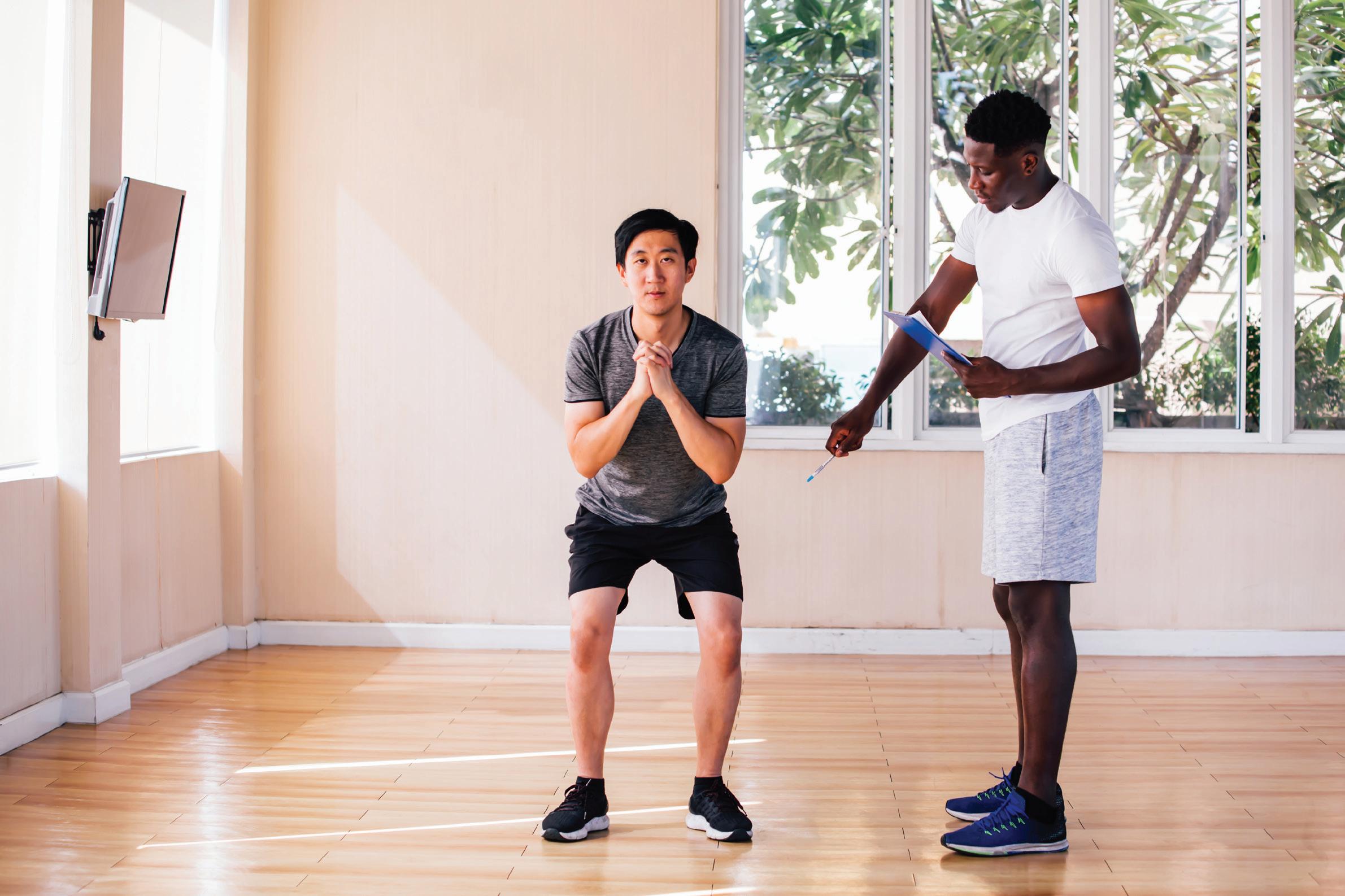
To be successful requires an in-depth knowledge of their unique individual needs, barriers and skills
|
You may recall working with a client that sometimes lacked motivation, signed up to work with you then disappeared for a while or missed appointments. Maybe they lost or forgot things often, had difficulty focusing or appeared like their head was in the clouds. This is not a reflection of you or a lack of interest or desire on their part. It may be because your client’s brain operates, processes and they behave differently from the societal “norm,” a concept known as neurodivergence.
By Jordon Hvizd
What Is Neurodivergence?
Neurotypical — someone who learns and develops skills similar to their peers in society. They can tolerate change, routine disruption and distractions with little difficulty.
Neurodivergent — anyone who processes things different from the perceived norm. This is not a specific mental health condition, learning or behavior disorder but rather comes from neurodevelopmental origin with long-term traits that do not change over time. People who consider
themselves neurodivergent may have a diagnosis of autism spectrum disorder (ASD), tourette’s syndrome, attention deficit hyperactivity disorder (ADHD), learning processing disorder and/or dyslexia among others.
Neurodiversity — an umbrella concept that moves away from labeling normal and abnormal and shifts focus to a spectrum of how each brain works, embracing all differences. There are no two brains the same, and thus there is no right way to view and experience the world around us.
22 | WWW.PERSONALFITNESSPROFESSIONAL.COM | SPRING 2023
Neurodivergence encompasses everyone who veers slightly or significantly off-course from societal norms. With neurodivergence so broad, and ADHD a common neurodevelopmental disorder, there are things you need to know to be successful in training your neurodivergent ADHD clients.
Not Just a Wild Child
It’s believed that the estimated 4.4% of American adults with ADHD is an underrepresentation of how many adults actually have it. The Centers for Disease Control and Prevention (CDC) estimates 9.8% of children aged 3-17 received a diagnosis of ADHD, with the majority being boys at 13% compared to 6% of girls who received the diagnosis. It’s believed that girls and women go under the radar and are underdiagnosed with ADHD, presenting with inattentive characteristics as opposed to classic hyperactive presentation. Untreated ADHD can lead to low self-esteem, depression, anxiety, forgetfulness, shame, impatience, problems at work, home and in relationships. Reaching out to you as their trainer for help, may seem a simple task to you, but could have been a mountain for someone that is neurodivergent to overcome.
ADHD Starts in the Brain
Research has identified many attributing differences in ADHD brains including size and activity of some areas in the brain, neuron development and maintenance, as well as neurotransmitter dysfunction. Some areas of the ADHD brain develop faster and are more active, while some areas develop slower and are less active.
FAST: The motor region develops more rapidly, perhaps why we see more restlessness and fidgeting.
SLOW: Areas that mature slower, include the amygdala, accumbens and hippocampus, areas responsible for emotion regulation, working for reward and motivation respectively. The frontal lobe also develops more slowly, an area responsible for organization, attention and planning, as well as social skills and impulse control.
Neurotransmitters like epinephrine, serotonin, norepinephrine and dopamine help
regulate these complex brain messaging circuits and are involved in the stress response as well as conditions like depression and sleep disorders. Studies have supported the theory that the imbalances or deficiencies of these neurotransmitters, particularly norepinephrine and dopamine, cause symptoms of ADHD. These imbalances lead to difficulties with executive functioning skills leading to difficulty with attention, focus, concentration, memory, impulsivity, hyperactivity, organization, social skills, decision-making, planning, motivation, task-switching and transitions, working for reward and learning from past mistakes. Effective treatment options, like stimulants, aim to increase the availability of norepinephrine and dopamine in the brain, improving executive functioning and reducing symptoms. Although more research is needed, exercise is gaining momentum as an alternative or complementary treatment option for ADHD. Here’s why:
How does exercise impact the brain?
Moderate to high-intensity exercise boosts neurotransmitter levels
Stimulates the vagus nerve to help restore calm, allow focus on problem solving and regain executive function control after times of high stress
Boosts brain-derived neurotrophic factor important for brain development, plasticity, learning and memory processing
Releases those feel good endorphins that help boost mood, reap rewards and improve stress reactivity
Reduces impulsivity and hyperactivity, improves attention control and executive functioning
Effects are cumulative! Meaning the longer you exercise, the more lasting benefits you may gain
How to Help Your Clients Be Successful
Training neurodivergent clients requires an in-depth knowledge of their unique individual needs, barriers and skills. Tap into their superpowers and find out what their kryptonite is. ADHD often leads to an ability to hyperfocus, and people are creative, spontaneous and resilient con-
versationalists with high energy. Dive deep into what your clients’ challenges were in previous workout programs.
The Planning
ADHD minds can wander, and time blindness is real. Set time limits to prevent underestimating how long an activity may take them. Work out for time. The use of timers can be a reminder to move to the next exercise and to refocus. Create checklists for your clients’ home workouts — the dopamine hit from checking things off a list should not be overlooked. Create a personalized program that is both engaging and stimulating to prevent boredom.
The Workout
Provide structure and variety in a program that delivers both cardiovascular and non-cardiovascular exercises for full benefits. Nod to you, HIIT workouts!
Target the CDC guidelines of 150 minutes of moderate intensity activity (60-80 percent of maximum oxygen consumption, VO2max) divided into 30-40 minute sessions, 4-5 times per week.
The Cooldown
Integrate relaxation techniques into cooldown routines. Breath work, imagery and yoga are all beneficial techniques. Practicing these skills regularly during cooldowns and on rest days may help your client better utilize these techniques when big emotions arise and emotion regulation is challenged. Reward your client with positive feedback. Recognize the challenges they have overcome and progress made. After all, progress is progress, no matter how small.
Jordon Hvizd, a health and wellness advocate as co-founder of ActiveRx Ventures, Medical Writer, Physician Assistant, and Registered Health
and
Exercise Professional Personal Trainer.
She combines her passions, training, and purpose to create health and fitness content and personalized training programs for clients across the continuum of care. Follow her on Instagram or connect on LinkedIn @JordonHvizd
SPRING 2023 | WWW.PERSONALFITNESSPROFESSIONAL.COM | 23
SUBSCRIBE TO PFP HERE
FEATURE ARTICLE
By Aesha Tahir ToneAndStrengthen.com

TAMING THE HUNGER HORMONES
10 easy, science-backed tips that you can recommend to your clients to stabilize their leptin and ghrelin levels |
By Aesha Tahir
Did you know that a large percentage of your clients may regain all the weight they’ve lost within just one year? Would you like some evidence? A six-year study conducted on the popular “Biggest Loser” television show participants who lost dozens of pounds through diet and exercise had their waistlines rebounded by the end of the study. Some contestants weighed even heavier than before.
Hunger Hormones
Weight rebound is primarily due to the role of weight-regulating hormones in our bodies.
Hormones are the chemicals that travel in our bloodstream to tissues and organs that facilitate almost all the body’s processes, like growth, metabolism, sexual function and emotions. These chemical messengers play a vital role in weight loss and regain.

24 | WWW.PERSONALFITNESSPROFESSIONAL.COM | SPRING 2023
Ghrelin and leptin are two hormones that play a crucial role in weight maintenance, so stabilizing them is key to sustaining long-term healthy weight.




Ghrelin
Ghrelin, also known as the “hunger hormone,” plays a crucial role in weight maintenance. This hormone is produced in the gut when it’s empty. It travels in the bloodstream to our brain, signaling to the part of the brain called the hypothalamus that it’s time to eat. As ghrelin levels increase, they encourage the body to store fat. Low levels of ghrelin minimize hunger and fat storage.
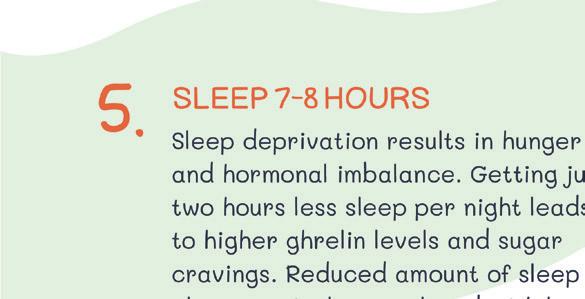

I know it sounds like an evil hormone, but it played a vital role in the survival of our ancestors, helping them store enough body fat for their daily high activity levels. Ghrelin follows the hunger cycle, rising before meals and dropping low about an hour after. Individuals over the healthy weight limit have lower levels of ghrelin but are more sensitive to it.


Ghrelin levels rise with weight loss. One of the primary reasons sustained weight loss becomes complicated is because restricting calories leads to increased ghrelin levels, making us hungry. However, certain eating habits discussed later in this article can help control ghrelin.
Just like ghrelin signals hunger, another hormone signals satiety to our brain.
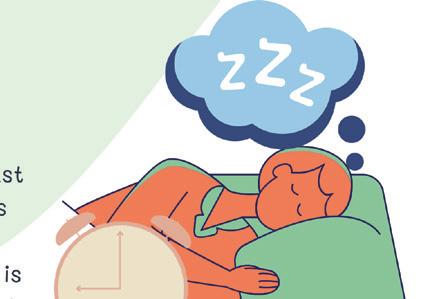



Leptin

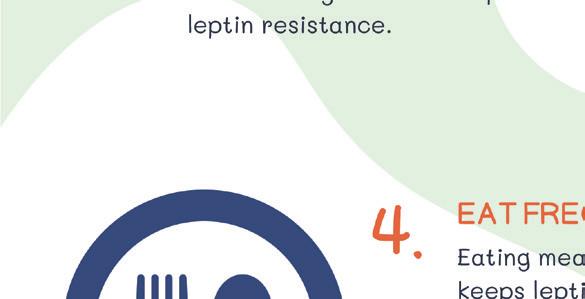
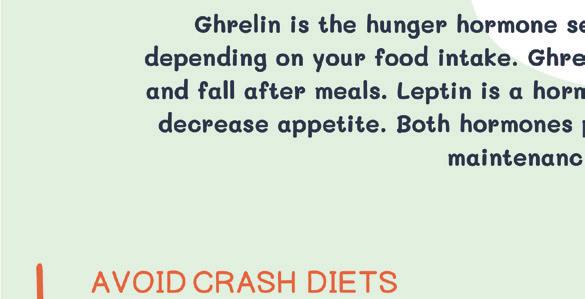
Ghrelin’s nicer sister is Leptin, a hormone made by our body’s fat cells that decrease our appetite. Leptin in our bloodstream travels to the hypothalamus and signals us to stop eating.
The higher number of fat cells the body has, the higher the amount of leptin in the body. This appetite-suppressor hormone’s levels are paradoxically lower when you’re lean and higher when you’ve more fat cells.
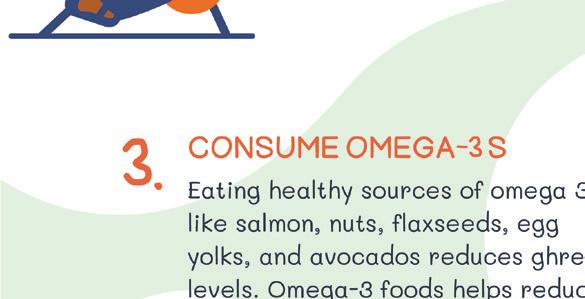

The answer to the obesity epidemic should be easy. Just give overweight clients leptin, and they will get thinner. But it’s not that easy!
Scientists studied the effect of leptin on obese mice. They were injected with leptin and were expected to decrease body weight. However, to scientist’s surprise, the mice didn’t lose weight because the obese mice were leptin tolerant.
SPRING 2023 | WWW.PERSONALFITNESSPROFESSIONAL.COM | 25
SUBSCRIBE TO PFP HERE
One of the primary reasons sustained weight loss becomes complicated is because restricting calories leads to increased ghrelin levels, making us hungry.
This research showed that leptin tolerance is the main contributor to obesity. When we eat more than our body’s daily energy needs, we increase leptin. When our body has too much leptin due to higher amount of fat cells, leptin signals to the brain stop working. Our brain mistakenly thinks that the body is starving and sends a false sign to eat more and conserve energy.
When we lose weight temporarily, our leptin resistance doesn’t reverse. Hence our clients who lose weight end up gaining back the weight they lost. This is the chief underlying mechanism of yo-yo dieting.
Treating the hormonal imbalance of these hunger hormones means considering many factors like obesity, health conditions, diet, sleep and lifestyle habits that throw our hunger hormones out of whack.
How to Stabilize Hunger Hormones
Here are some easy science-backed tips that you can recommend to your clients to stabilize their leptin and ghrelin levels. Stable hunger hormones minimize cravings, increase satiety and improve leptin resistance.
1. Avoid Crash Diets — Staying conservative with calorie-cutting is the best way to lose weight. Severe calorie-restrictive diets increase ghrelin production. Research on
obese individuals following a very low-calorie diet increased ghrelin in their bloodstream considerably. Prescribe moderate calorie reduction to your clients during the weight loss coaching.
2. Incorporate High-Intensity Interval Training (HIIT) — The best form of exercise to modulate ghrelin levels is HIIT and resistance training. HIIT reduces ghrelin and suppresses appetite, while resistance training helps gain muscle, increasing human growth hormone production and hindering ghrelin production.
3. Eat More Protein — Foods rich in protein and healthy fats like chicken, fish and tofu at each meal will help your clients to fight hunger. These macronutrients slow the digestive process keeping us satiated for more extended periods which keeps ghrelin levels low.

4. Consume Resistant Starches — Eating foods rich in resistant starch, a carbohydrate resistant to digestion and supports healthy gut bacteria, suppresses appetite by boosting leptin function. Lentils, oats and sweet potatoes are rich in resistant starch.
5. Fiber Is Our Friend — Consume fiber-rich nutritious vegetables like brussels sprouts, broccoli, spinach and squash. These vege-
tables fill our stomachs with fiber and water, dropping our ghrelin levels.
6. Limit Fructose in Diet — Fructose that is found in packaged food has a marked negative effect on hunger-regulating hormones. It increases ghrelin production. Avoiding fructose intake for your clients will pay huge dividends.
7. Eat Omega-3 Rich Foods — Foods rich in omega-3 fats help the functioning of leptin your body. Eating healthy sources of Omega-3 like salmon, nuts, flaxseeds, egg yolks and avocados reduces ghrelin levels by increasing satiety.
8. Eat Often — Recommend eating frequent meals and snacks to your clients. Eating regular meals and snacks throughout the day keeps leptin and ghrelin levels stable. Mini meals help satisfy the appetite and provide nutrients to the body throughout the day.
9. Manage Stress — Promote stress-reducing activities like meditation, yoga, massage and walking in nature. Chronic stress stimulates ghrelin production. Partner with wellness professionals who are experts in stress reduction modalities. It will help you to cross-promote each other’s business and can be a great way to enhance your professional network.
10. Get Enough Sleep — Sleep deprivation results in hunger and hormonal imbalance of satiety hormones. Just two hours less sleep per night leads to higher ghrelin levels and excessive sugar cravings. Reduced amount of sleep is also negatively correlated with leptin levels.
Achieving sustainable weight loss is possible. Our hunger hormones respond best to a healthy lifestyle. Focusing on healthy habits and creating an environment that encourages consuming healthy foods, reducing stress and moving our bodies can lead to long-term healthy weight.
Aesha Tahir is an exercise scientist and has many years of experience in the fitness industry as a personal trainer, professional educator and entrepreneur. She is the founder and operator of ToneAndStrengthen.com. She has helped many clients reach their fitness goals and attain better posture. Aesha is also guest DEI columnist for PFP. Follow her on IG @tone_and_strengthen.
26 | WWW.PERSONALFITNESSPROFESSIONAL.COM | SPRING 2023































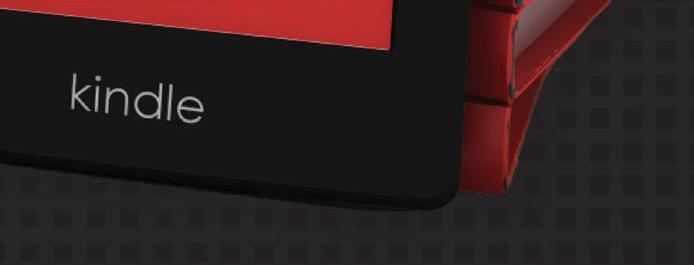


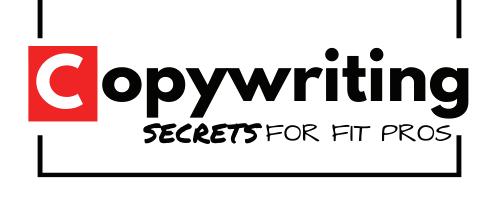

WWW.WHYDOYOUHATEMONEYBOOK.COM/PFP-GIFT GET INSTANT ACCESS To Content & Marketing Secrets Used To Generate Over Multiple Millions In The Health, Fitness, & Wellness Industry Special Offer For PFP Subscribers ONLY... WWW.WHYDOYOUHATEMONEYBOOK.COM/PFP-GIFT ✓ MARKETING SECRETS This book reveals the same marketing secrets little-known coaches use to fill $500-$10k online programs from tiny audiences – without over-hyped claims, monster ad budgets, or bait-and-switch tactics. FREE DIGITAL COPY SENT DIRECTLY TO YOUR INBOX Scan here or follow the link below to download your copy today!
DIVERSITY, EQUITY AND INCLUSION
 By Sheldon McBee
By Sheldon McBee
Create exceptional and inclusive experiences through coaching and cueing
When we create an environment for our clients to feel welcome, appreciated, represented, valued and heard we clearly know we are addressing diversity and inclusiveness in our services. All industry indications point towards increased market penetration and revenue growth. That said, the majority of potential exercisers still lack the motivation to initiate and sustain an exercise routine and much of this is rooted in the potential lack of perceived competence and sense of belonging. This narrative penetrates many cultural lines that include race, gender, ethnicity, disability, age, socio-economic status and overall experience.
As personal trainers, instructors and coaches we are in a unique position to make a difference to lift the veil of representation. This is
not just done in management, marketing, staffing and onboarding, but through the way we actually coach in live settings. The ability for instructors to embrace and execute coaching actions and language can be an absolute game-changer for increasing the likelihood that people feel like they belong. Following are three tips you can consider whether you are a private one on one personal trainer, small group personal trainer, or group exercise instructor to create exceptional and inclusive experiences through your coaching and cueing.
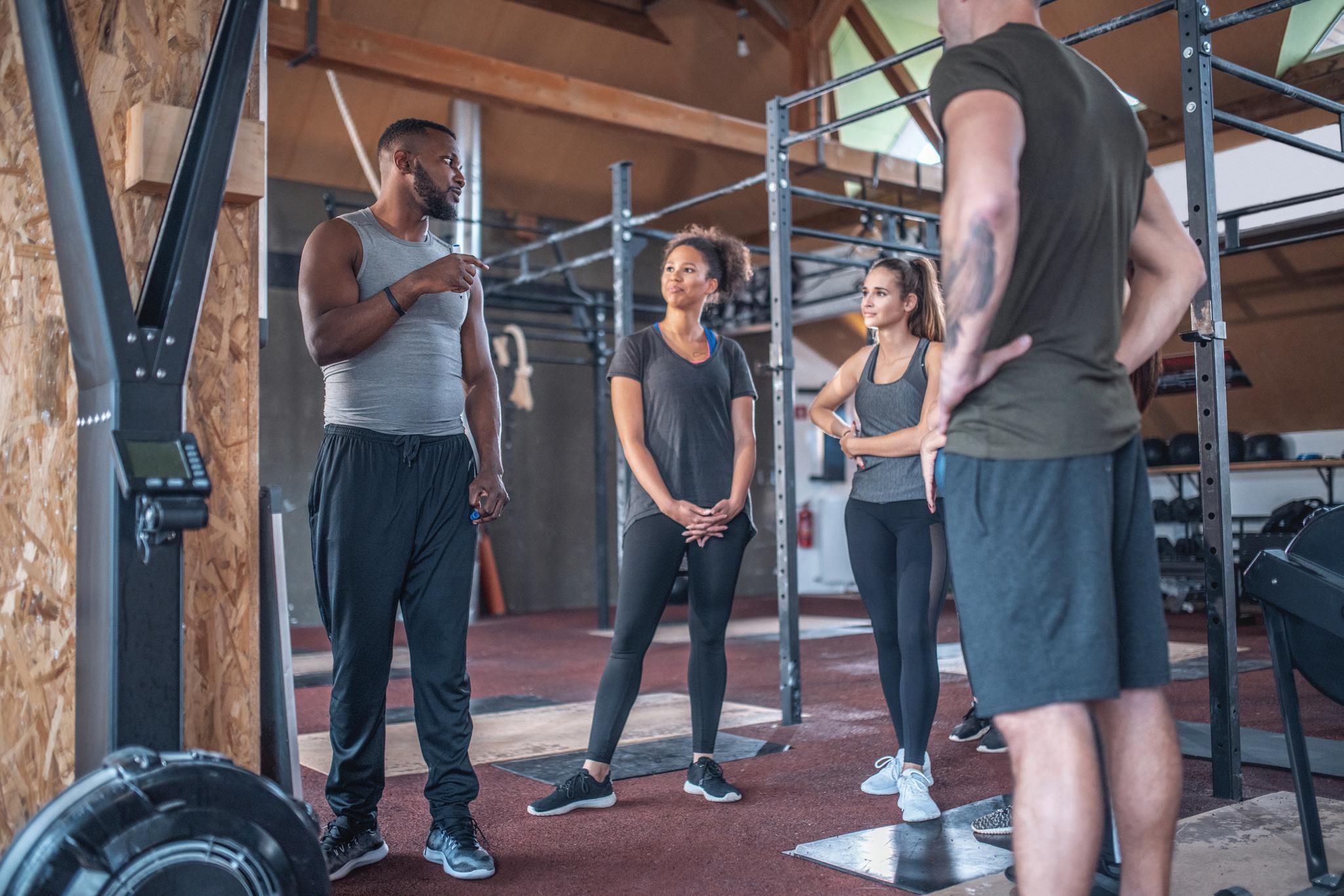
1. Achievable language
The first thing to consider is using coaching language that allows your client or class to feel that what you are asking of them is both achievable and comes with choice. It is well documented that intrin-
28 | WWW.PERSONALFITNESSPROFESSIONAL.COM | SPRING 2023
sic motivation is highly impacted by an exerciser's perception that they have a choice in their experience. This may include options, regressions, correctives, load, rest intervals and more. You can imagine the old school drill sergeant instructor who forces the class to push beyond their capacity. Many of us may perceive this as a good thing. The downside is that this will satisfy the motivational needs of the few. Most new exercisers, or those who prioritize a sense of achievement through completion, will feel like they are failing unless their exertion matches their perceived expectations set by the coach. Encourage clients to choose loads and progressions that give them ownership session by session. Give permission to members to push at their own version of scaled exertion during vigorous exercise and praise their choice and effort. As a coach if you want to create a culture that encourages inclusion and equity this is a powerful tool to practice.
rience. Of course, we want to remember names, introduce people, create social groups and the like. There is another layer of the onion to peel here. This is an especially powerful tool in small group sessions, large team sessions or group fitness classes. Expressing the peaks and valleys of the workout experience with words like “together,” “we can/we are,” or “with someone next to you,” will trigger feelings of belonging. If private one-on-one training is your thing you can certainly still create this with client team stream calls to share experiences, creating social media groups with your roster and social events.
3. Tone
The third tip is to learn and apply the basic soft skills of tone. Not the type of tone that means a sculpted six pack and arms! What I reference here is the use of language, imagery, exercises and interactions that celebrate uniqueness and does not further isolate marginalized groups. There are a significant number of resources on how to improve tone without feeling like one must be “tone policed.” For the sake of keeping this article simple and applicable let’s lay out two simple things.
The first is to be cognizant of using language that exacerbates a stereotype. This may include highlighting the quality of performance based on ethnicity, age or experience. In contrast, a coach can simply encourage effort, engagement and focus on being authentic.
It is also a great best practice to use coaching language that helps clients recognize their level of competence in the moment versus the long term. An example of this may be to cue a client through proper alignment in plank for a programmed time. You may offer clear praise for their effort, and bring to light how this may translate into their next session by adding a slight progression. This can also be achieved by praising effort and micro-progressions in execution of an exercise bout versus the end result or a potential goal that may be reached months from now. Your ability to coach and cue small wins in the moment will increase your clients desire to return due to their increased sense of competence. As a coach if you want to create a culture that encourages inclusion and equity this is a powerful tool to practice. More clients will feel a sense of achievement and motivation regardless of their background and experience.
2. Community
The second tip is to proactively create community within your classes or client roster. It is only natural that we as human beings have a desire to want to be accepted and be around people who truly care about us. A great coaching tip is practice using language that draws people into the unified experience versus their own isolated expe-
The second is to be mindful that we want to be clearly understood and followed as fitness professionals. We need to speak clearly, demonstrate patterns, articulate our words and confirm our clients’ understanding of the exercises. While this may sound like this skill is a win, it’s critical to have the emotional intelligence to avoid sounding condescending or patronizing in the attempt to be too clear. A best practice here is to be aware and sensitive about your delivery. Be willing to ask for and accept feedback. If there are any small nuggets of behavior you can apply one step at a time, give it a try!
We are very fortunate to be in an era where more consumers are looking for opportunities to move to improve their health. We all have our niche that we serve to our target market, but we can create a massive change in our industry by keeping diversity, equity and inclusiveness at the forefront of our model. Not just our business model, but our coaching model as well.
SPRING 2023 | WWW.PERSONALFITNESSPROFESSIONAL.COM | 29
As personal trainers, instructors and coaches we are in a unique position to make a difference to lift the veil of representation.
SUBSCRIBE TO PFP HERE
Sheldon McBee MS, is an Executive Director for Universal Athletic Club based in Lancaster, PA. He has a Master’s in Human Nutrition, is an ACE-certified Personal Trainer and has over 20 years’ experience in health and fitness. Sheldon is an international presenter, lecturer, business consultant, fitness content developer and personal training director. He has presented at IHRSA, IDEA, SCW, CanFitPro, and has been featured in numerous industry publications. He currently sits on the CanFitPro and Club Solutions Magazine Advisory Panels.
V2 MAX PLUS™ REFORMER - ONYX
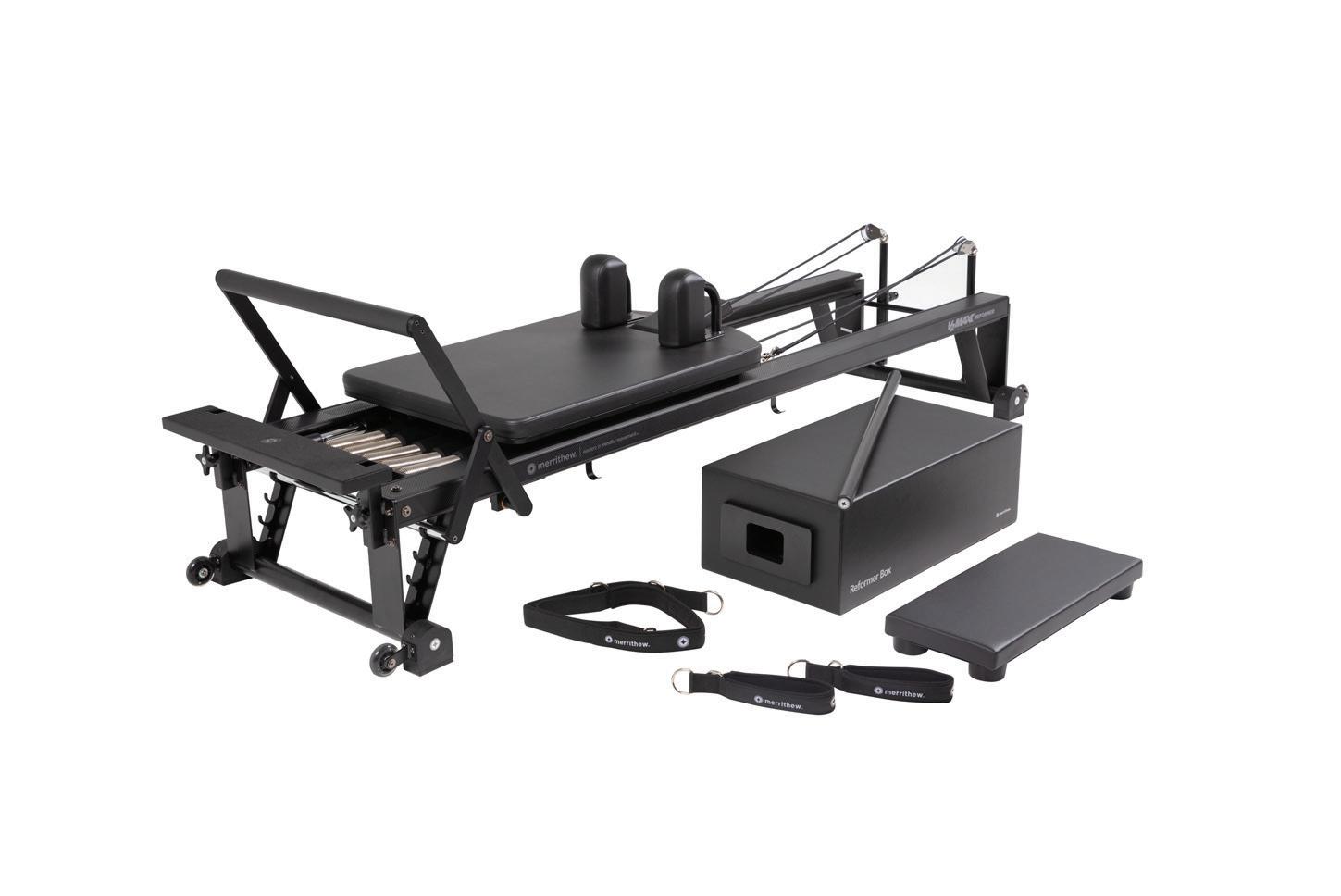

The new all-black V2 Max Plus™ Reformer - Onyx is a sleek and stylish Pilates machine that facilitates limitless exercise possibilities. This one-of-a kind unit multi-tasks as a raised Mat platform, a standard Reformer, a virtual Cadillac and a breakthrough multi-planar, biomechanics training tool. Equipped with our innovative retractable rope system and travelling pulleys on the Vertical Frame, the V2 Max Plus offers variable angles of resistance, providing an increase range of motion, making it the premier tool for Pilates-based sportspecific, rehab and cross-training movement.
Merrithew.com
HEALTH & FITNESS MARKETING BIBLE (BEST-SELLER)

Most people choose a career in health and fitness because it's changed their life and they want to return the favor. Problem is, if you can’t communicate effectively you’re going to get lost in the noise. Why Do You Hate Money reveals an ethical approach to marketing for health and fitness professionals. Whenever you're ready to continue building a successful business around your passion — download your FREE digital copy (PFP subscribers only). www.whydoyouhatemoneybook.com/ pfp-gift

FITTERFIRST FITFOOT™
FitFoot is a lightweight foot and leg exerciser to improve circulation, strength, mobility and range of motion in foot, ankle and calf muscles. Healthy foot and calf ankle pumps increase venous return and arterial blood flow; important in preventing clot formation, swelling and age-related cognitive decline. A musthave for long range travelers, those with vascular conditions, diabetes, edema or joint-related injuries. FitFoot folds flat for transport and storage and can be used for seated exercise anywhere.

Fitter1.com/products/fitfoot
SELECTORIZED DUALS
A new series of Selectorized Duals from Spirit Commercial Fitness combine two exercises into one machine, allowing the users to get in twice the work, in half the space. This new series is ideal for vertical market facilities or any place where space is limited. A full-body workout can be achieved using half the normal number of machines found in full-size gyms. This series consists of 5 new products that are each designed with integrated rep counters, build in storage, premium padding, colored adjustment knobs and heavy-duty construction.
SpiritCommercialFitness.com/Selectorized
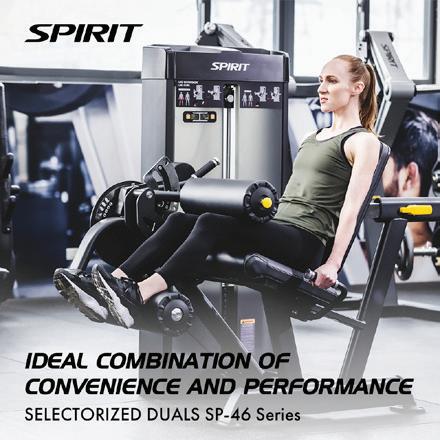
INSTA- PULSE® MODEL 2103
See every beat of your heart, heart rate and heart rate variability with a new Insta-Pulse heart rate monitor Floor Model- 2103, which implements a new proprietary and patented technology of ECG/ EMG sensors. The Insta-Pulse monitors continually instant heart rates with simple touch of antibacterial sensors in a club, school or any fitness facility or personal exercise room. The Insta-Pulse® model 2103 is maintenance free, 9 volt standard battery operated.
Heart-Rate-Monitors-Insta-Pulse.com
30 | WWW.PERSONALFITNESSPROFESSIONAL.COM | SPRING 2023
The latest trends in fitness equipment NEW ON THE MARKET










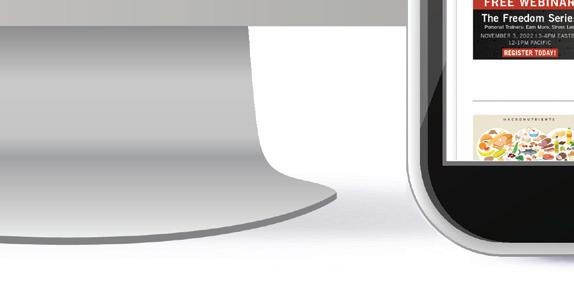






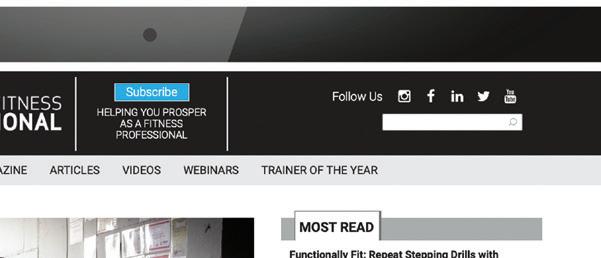

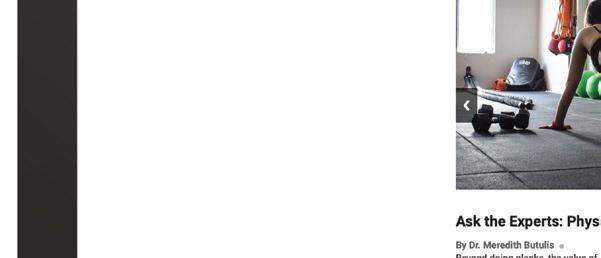


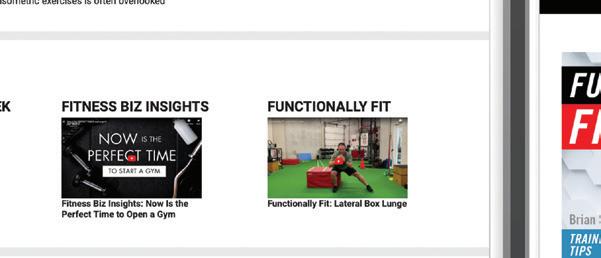
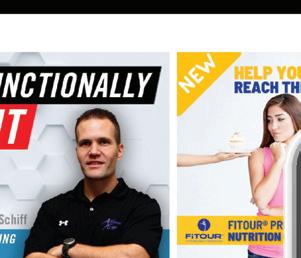


IT’S TIME TO RENEW YOUR FREE SUBSCRIPTION TO PERSONAL FITNESS PROFESSIONAL (PFP). IT’S FAST AND SIMPLE. Through our magazine, website (www.PersonalFitnessProfessional.com), eNewsletter and our social media tools, Personal Fitness Professional (PFP) brings you the information you need to be successful with clients, keep up on the latest trends in the fitness industry and earn more money while doing what you love. www.PersonalFitnessProfessional.com/renew
FiTOUR®
AFAA
NASM
Study
PLUS
If you renew now, you will be entered to win one of three FREE
ACE,
or
approved CEC Home
Courses ($39.99 value each)!
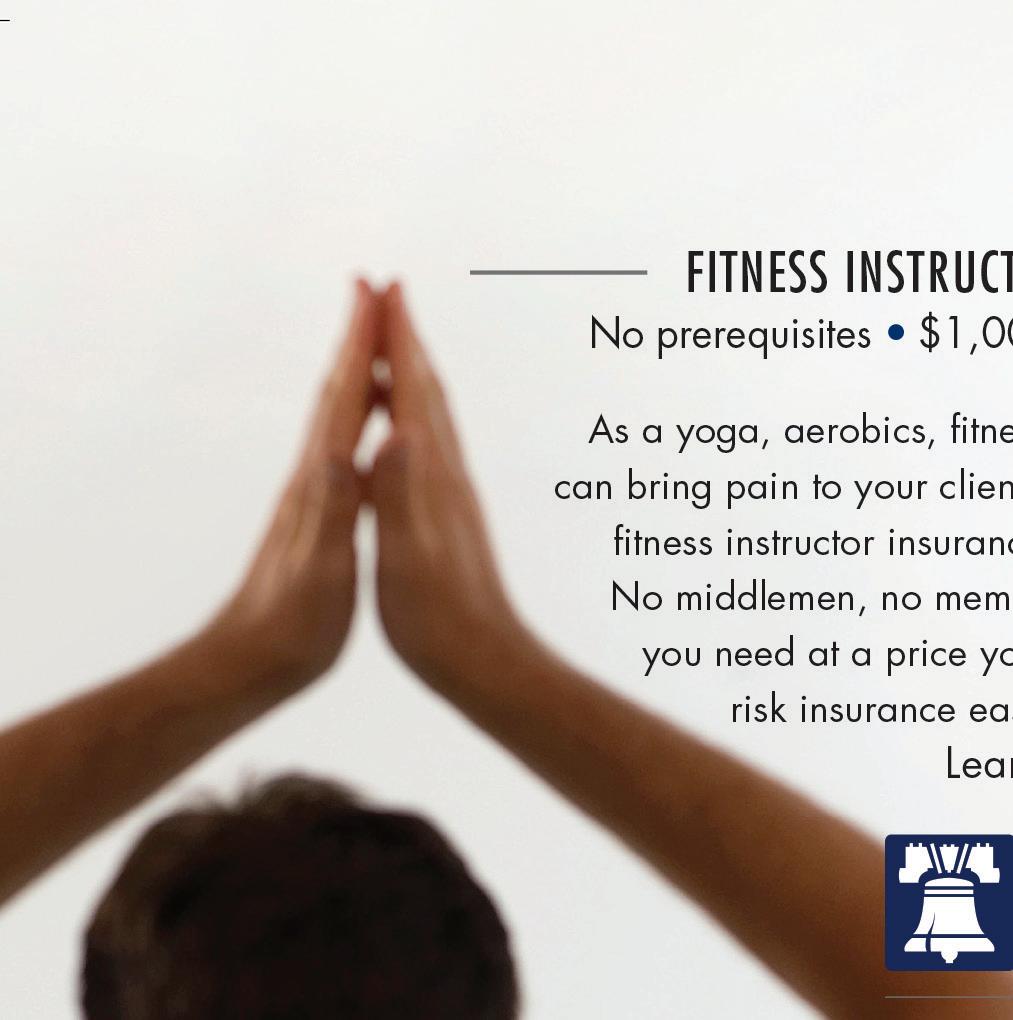




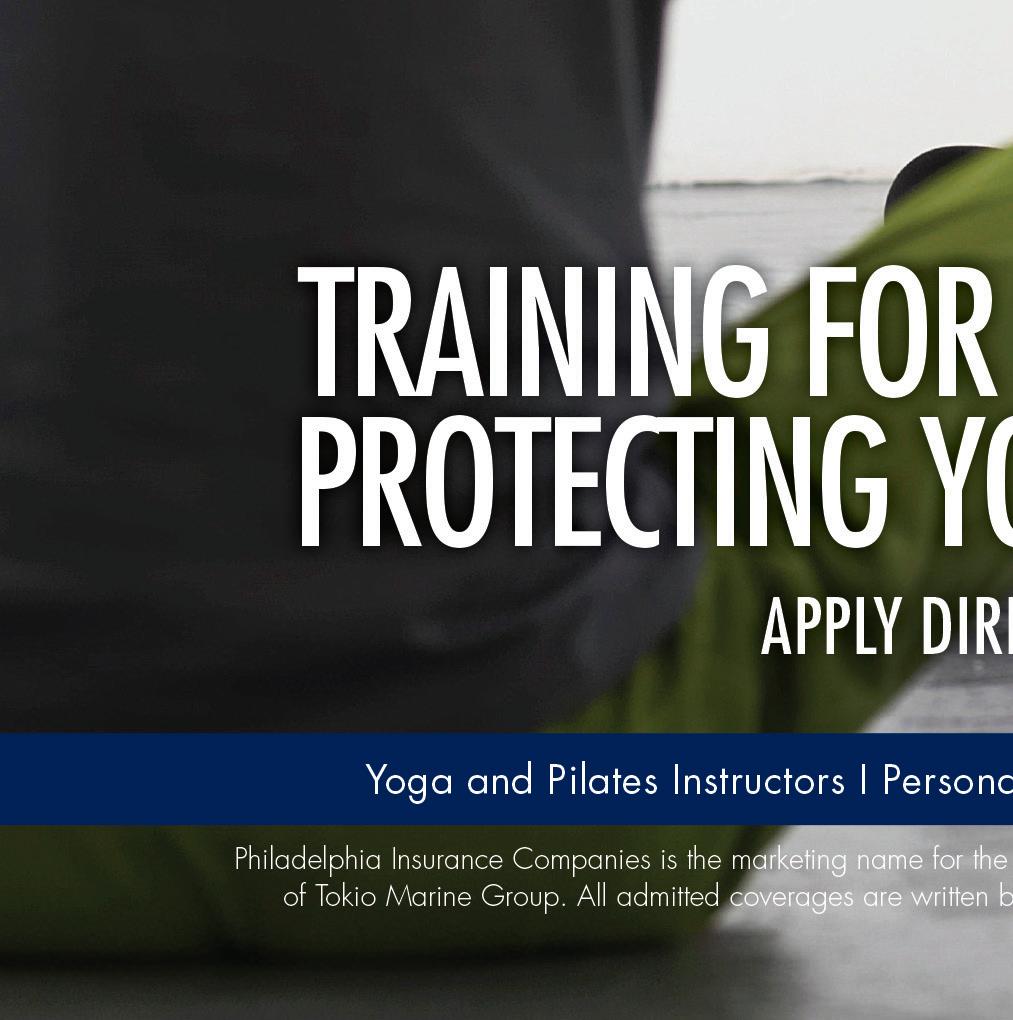
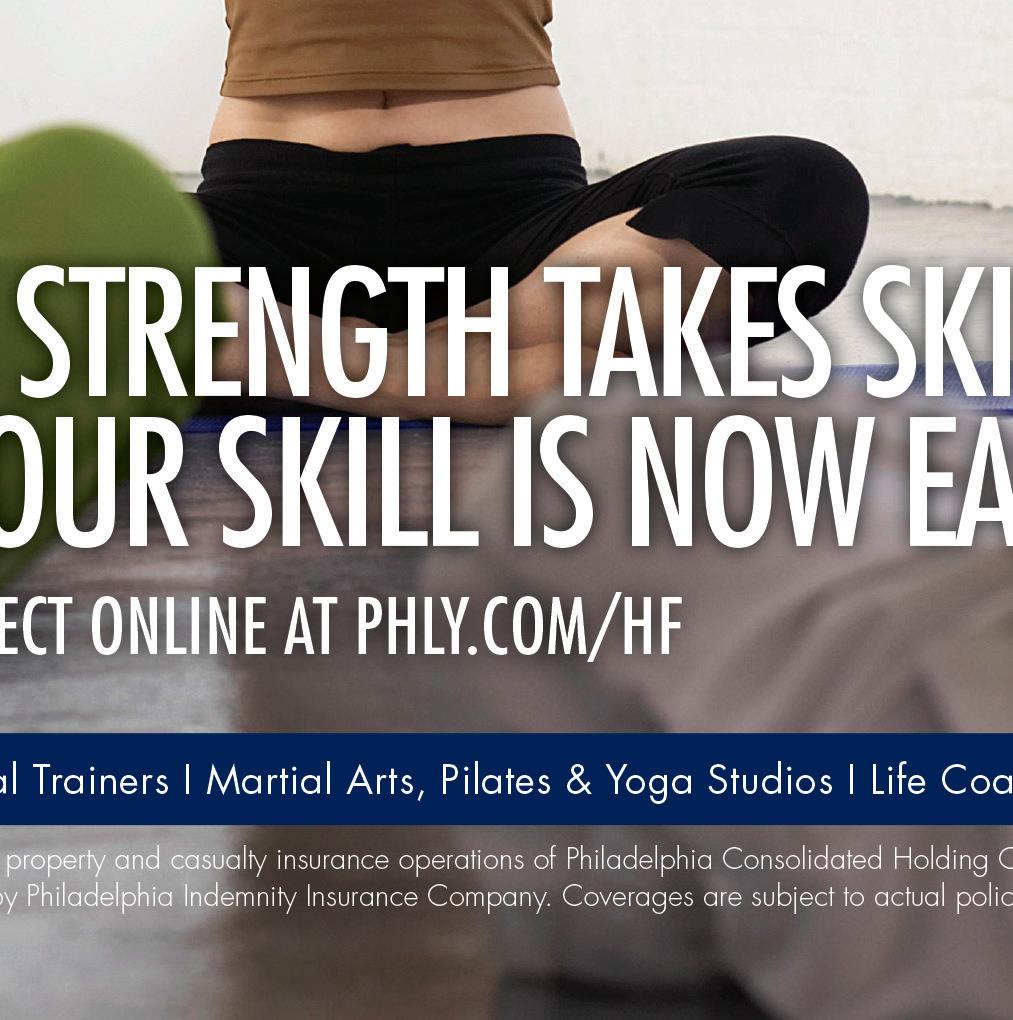
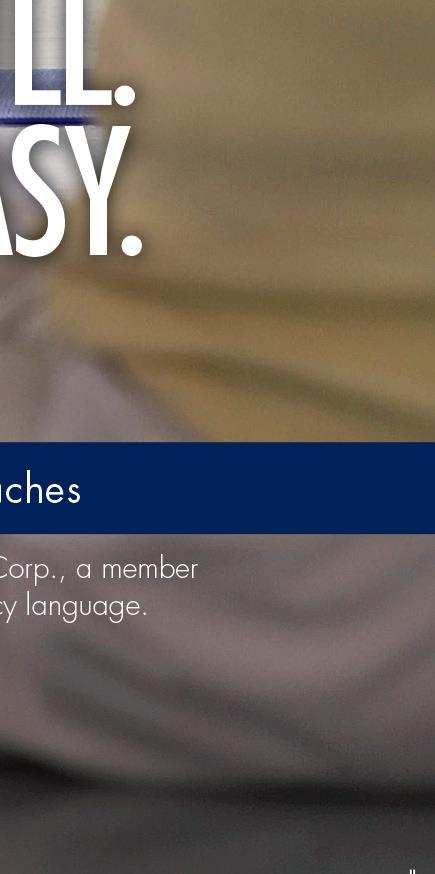
































 By Aesha Tahir
By Aesha Tahir













 By Kurt Weinreich Jr. KurtWeinreich.ISSACertifiedTrainer.com
By Kurt Weinreich Jr. KurtWeinreich.ISSACertifiedTrainer.com









 By Dr. Meredith Butulis MeredithButulis.com
By Dr. Meredith Butulis MeredithButulis.com






















 By Jordon Hvizd
By Jordon Hvizd
























































 By Sheldon McBee
By Sheldon McBee








































